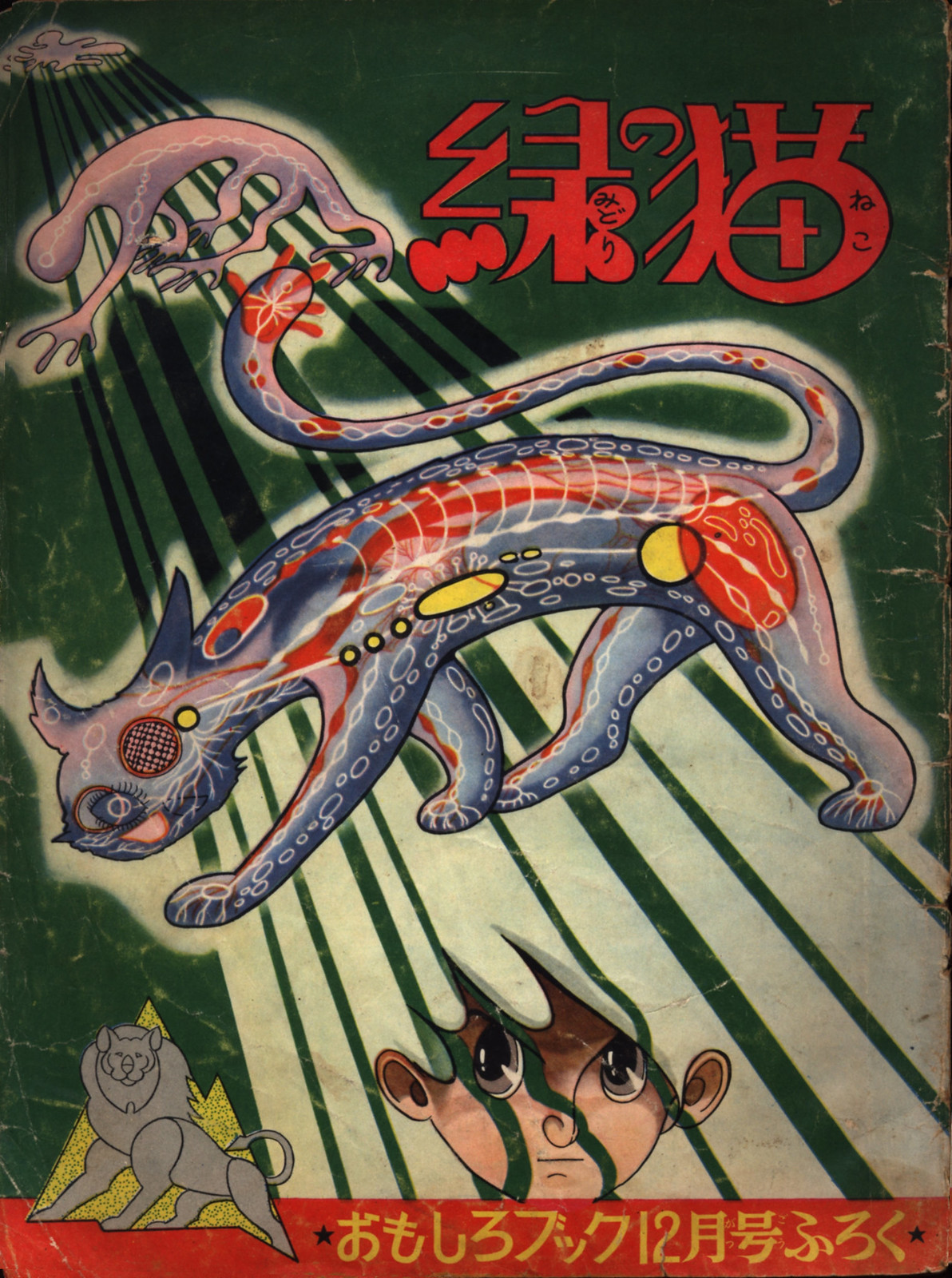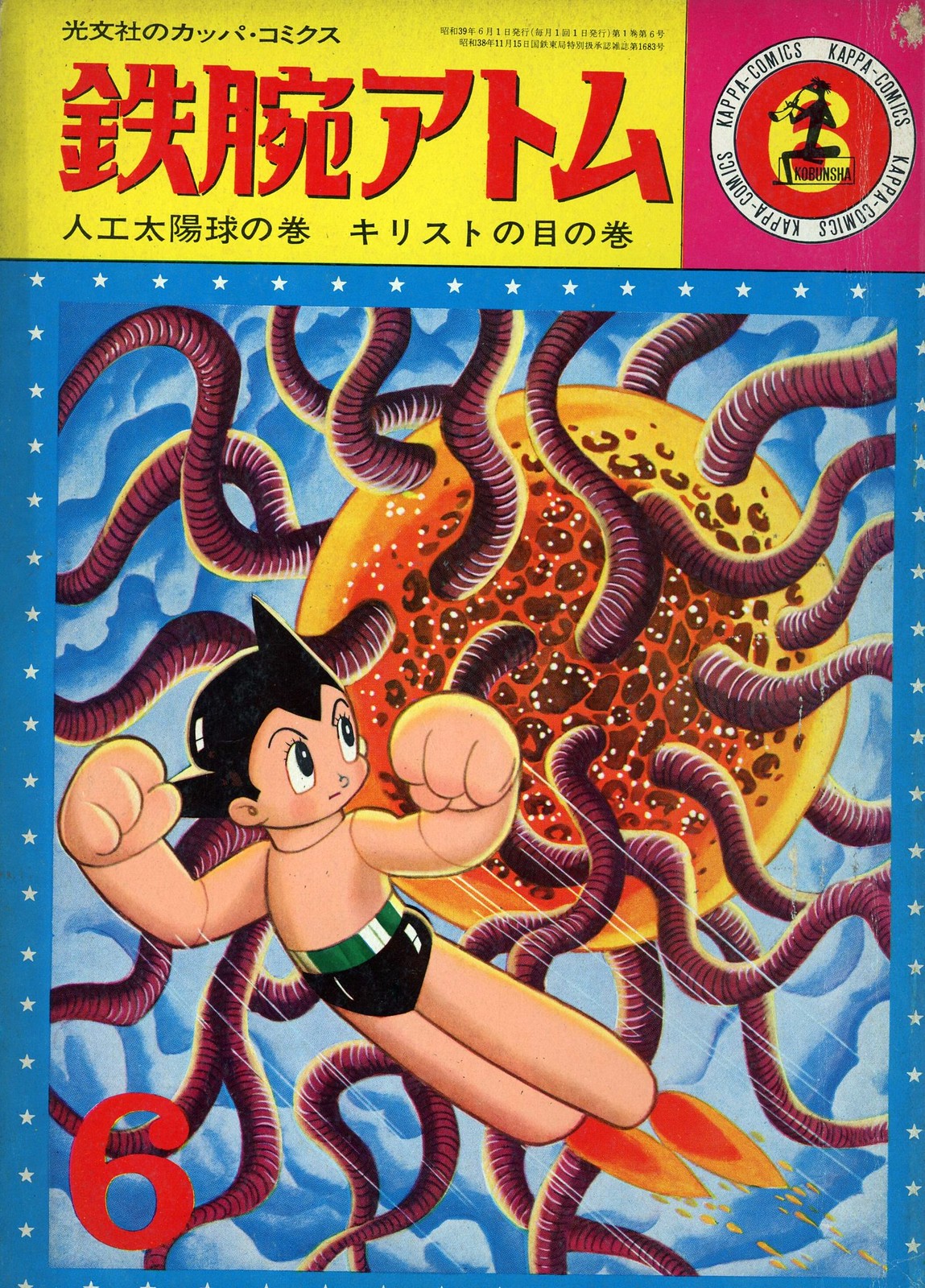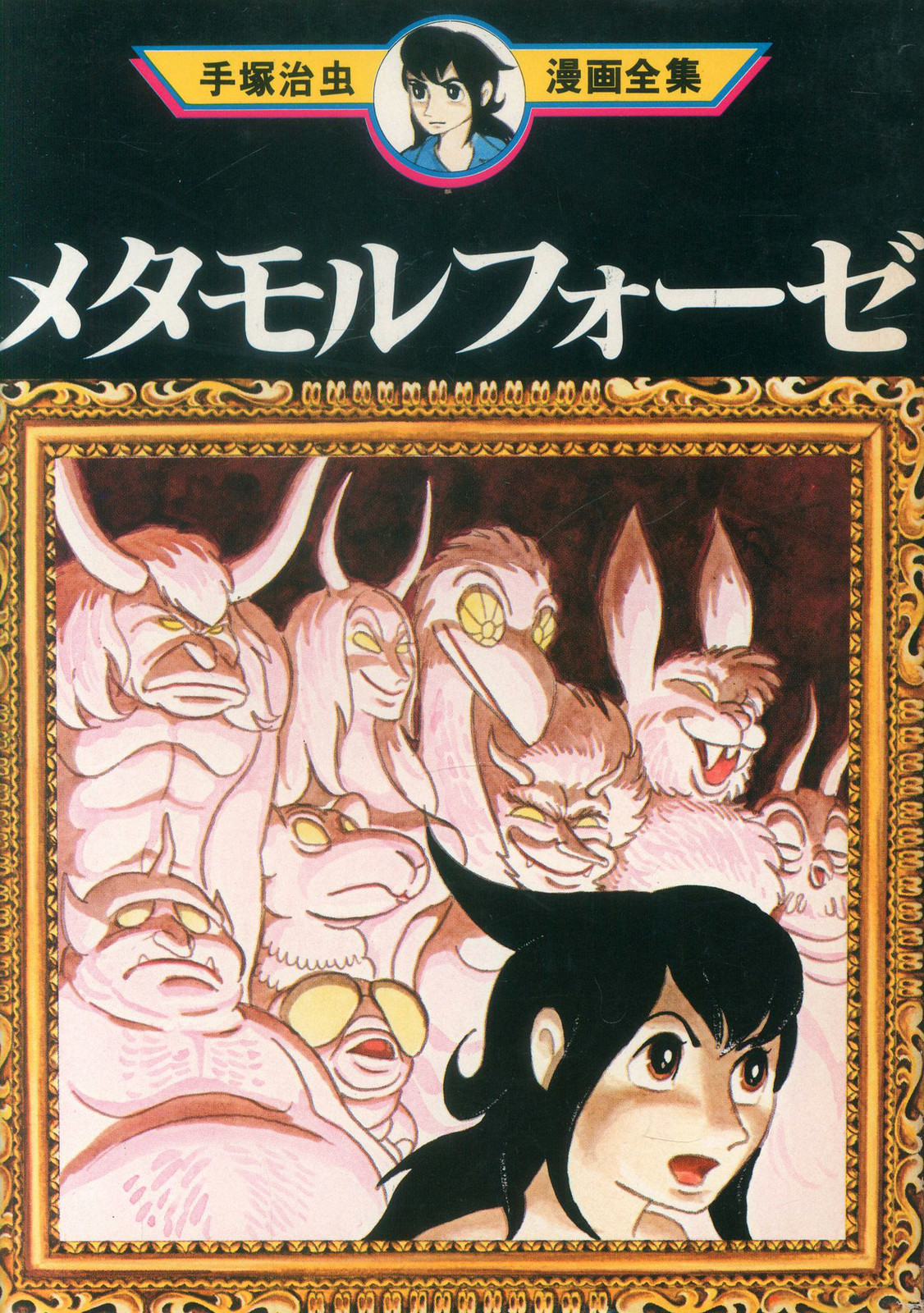Feed aggregator
Extracurricular Esoteric Endeavours III
 The publisher 12 to Midnight has developed its horror setting of Pinebox, Texas through a series of single scenarios written for use with Savage Worlds, the cinematic action RPG rules from Pinnacle Entertainment Group. In July, 2014, following a successful Kickstarter campaign, the publisher released the setting through a particular lens and timeframe, that is as students at East Texas University. Over the course of their four-year degree courses, the students undertake study and various academic activities as well as having a social life, a job, and even an annoying roommate. Then of course, there is the weird stuff—ghosts, werewolves, vampires, and more… The challenge of course is that the students have to deal with both, but need to grow into being able to cope with both.
The publisher 12 to Midnight has developed its horror setting of Pinebox, Texas through a series of single scenarios written for use with Savage Worlds, the cinematic action RPG rules from Pinnacle Entertainment Group. In July, 2014, following a successful Kickstarter campaign, the publisher released the setting through a particular lens and timeframe, that is as students at East Texas University. Over the course of their four-year degree courses, the students undertake study and various academic activities as well as having a social life, a job, and even an annoying roommate. Then of course, there is the weird stuff—ghosts, werewolves, vampires, and more… The challenge of course is that the students have to deal with both, but need to grow into being able to cope with both.The ETU or East Texas University setting is fully supported by Degrees of Horror, a complete plot point campaign that builds and builds over the course of Study Group’s four-year degree courses. A plot point campaign differs from a standard campaign in that it is a framework of scenarios that advance the plot around which the Game Master can fit and run single scenarios not necessarily pertinent to the campaign’s core plot. These can be of the Game Master’s own design or bought off the shelf—several are available for the setting. The plot points are triggered under certain circumstances; it might be because the Player Characters visit a particular location or because of an action that they have taken. In Degrees of Horror the plot points are also built around areas of academic study and the year in which the Player Character student—or Study Group—are currently in. What this means is that in Degrees of Horror, the Study Group will encounter the first notions of the outré things to come in the first term as Freshmen and both the campaign and the Study Group’s investigations will come to fruition as Seniors at their graduation. However, what happens if the administration and the Dean at the university become aware of the Study Group’s activities? What if the Study Group manages to deal with a threat, but manages to bring outside attention to the strangeness going on at the university in the process and the Dean wants the members of the Study Group out of the way? The Dean cannot expel them, because that would arouse more attention, so what can he do? Well, he can send them abroad. Abroad where they will be out of harm’s way! Abroad where there are no supernatural dangers! Abroad where they cannot get into trouble!
East Texas University: Study Abroad offers not one, but four options for the Study Group which wants to see foreign climes and the Game Master who wants to take her campaign elsewhere—if only for a little while. The options include Costa Rica, Italy, Poland, and the United Kingdom. Each chapter includes background and history for the country, cultural differences, descriptions of the institutions where the Students will be studying, a number of Savage Tales (or scenarios) which the Game Master can run over the course of the Semester that the Study Group spends there, and full stats for all of the NPCs, monsters, and other threats that the Students will encounter as part of their investigations. One major cultural difference which is highlighted in each of the four countries is the lack of access to firearms, which may or may challenge some players and their characters in addition to the change in setting and culture. Of course, an East Texas University campaign is unlikely to use all four of settings in East Texas University: Study Abroad, so for those that go unused, the Game Master has a ready supply inspiration for Savage Tales of her own and the monsters to go with them. The anthology already includes a selection of fellow exchange students from around the world which the Game Master can include as NPCs alongside the Player Characters.
The anthology opens with Costa Rica. Geographically, this is the closest to Texas, and culturally it feels not dissimilar too—though of course, there are plenty of differences. The Students will be studying at the Tejas Learning Campus which turns out to be a secret outpost for the Sweet Heart Foundation, one of the major villains from Degrees of Horror. The isolated nature of the campus means that its research can be conducted away from prying eyes and the local cryptids, including Chupacabras, are suitable for both study and experimentation. These are not the only local cryptids that the Students will face, but they are the primary ones. All too quickly, the Students will discover why they have a newly and very recently appointed counsellor as their guide, have both a black dog and white dog stalking them, take one or terrible field trips, and discover quite why it is not a good idea to visit the local town alone—especially if you are female. Whilst there is a good variety of Savage Tales here, they still feel connected to the plots the Students left hanging back in Texas, almost as if they never left. Several of them could easily back to Texas, or at least the south west of the USA without too much difficulty, which cannot be said of the other three Foreign Exchange settings.
The Italy trip takes the Students to the northern city of Turin. Here they will find The Egyptian Museum, the Lombroso Museum—the Museum of Criminal Anthropology—which houses numerous remains of criminals and ‘madmen’, so is likely home to numerous ghosts, and of course, the Shroud of Turin. There are plenty of secrets too, mostly in the extensive network of tunnels below the city. Both museums feature in the first two Savage Tales, whilst the third takes the Students into the tunnels below the city. With just the three Savage Tales, all of them decent, the chapter feels somewhat underwhelming, but in fact, there is a lot here that the Game Master can develop herself, especially as there are several villains which the chapter does not make use of.
The horror in the Poland chapter is definitely Slavic and Jewish in nature—the Morowa Dziewica (murrain maiden), an old crone which bears the plague; the Dybbuk, or those possessed by a spirit; the Upir or ‘peasant’ vampire; and the Rusalka, spirits of women who lead others to their deaths. The Students will encounter one or more of these whilst studying in Białystok in the cold north east of Poland. Again, there is a lot of background and cultural detail here, but instead of sperate Savage Tales, this supports a mini-campaign consisting of five Savage Tales. The strangeness starts almost straight away, with an attack by a fellow student with a surprisingly explosive temper and creepy encounters at a puppet theatre, both of which bring the Students to the attention of certain interested parties, some who want their help, some who do not. The last three Savage Tales focus on the campaign, an investigation into a series of missing persons cases, which includes more than the one option for defeating the villain, one of which amusingly mundane. As a chapter and mini-campaign, the Poland chapter is a pleasing diversion away from the main campaign back at East Texas University if the Game Master is running Degrees of Horror.
The last chapter in East Texas University: Study Abroad is set in merry olde England at Ascalon University near the village of Uffington. The village, once the home of poet John Betjeman, is real even if the university is not, but the chapter incorporates plenty of the local features and history into its setting and accompanying Savage Tales. After a trip from Heathrow to Uffington, which not only highlights the fun of travel in the United Kingdom, but which is also literally beset by Gremlins, the Students settle in only to discover that death and strangeness has followed them! Like the Poland chapter before it, the Savage Tales in the England chapter before it builds towards a mini-campaign, but of course grounded in British folklore, legends, and the poetry of John Betjeman. It is perhaps not quite as focused as the campaign in the Poland chapter, but once it gets going, it has a sense of the bucolic and the ethereal to it. Again, this is a pleasing diversion away from the main campaign back at East Texas University if the Game Master is running Degrees of Horror.
Physically, East Texas University: Study Abroad is well presented and well written. It needs a slight edit in places, but the artwork is excellent and the maps clear and easy to read.
East Texas University: Study Abroad is solid addition to the East Texas University campaign setting and diversion away from the events of Degrees of Horror. Its use is limited though. The Game Master is unlikely more than one or two of these in an East Texas University campaign, but the anthology can be used in serval ways. As a diversion, but still with links back to the main campaign back home, as in the Costa Rica chapter; as a diversion of unconnected adventures as in the Italy chapter; or as separate mini-campaigns, as in the Poland and England chapters. The Poland and England chapters are the more engaging of the quartet, the Poland chapter in particular. Then of course, whatever that the Game Master does not use, she can draw from for inspiration for her own campaign, and there is always scope to develop further Savage Tales and drop them into the chapters as needed. Certainly, both the Poland and England Chapters could be developed into longer campaigns if the Game Master wanted to do so.
Shigeru Mizuki (1922 - 2015)






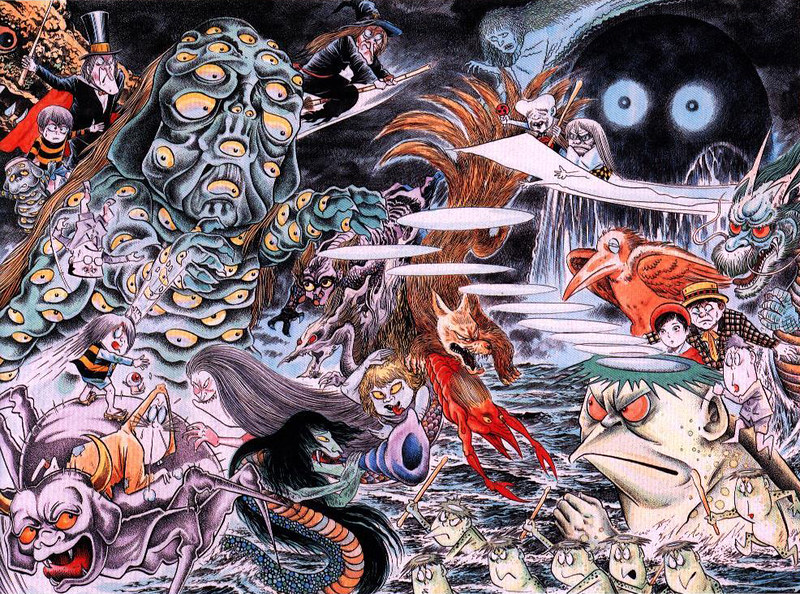
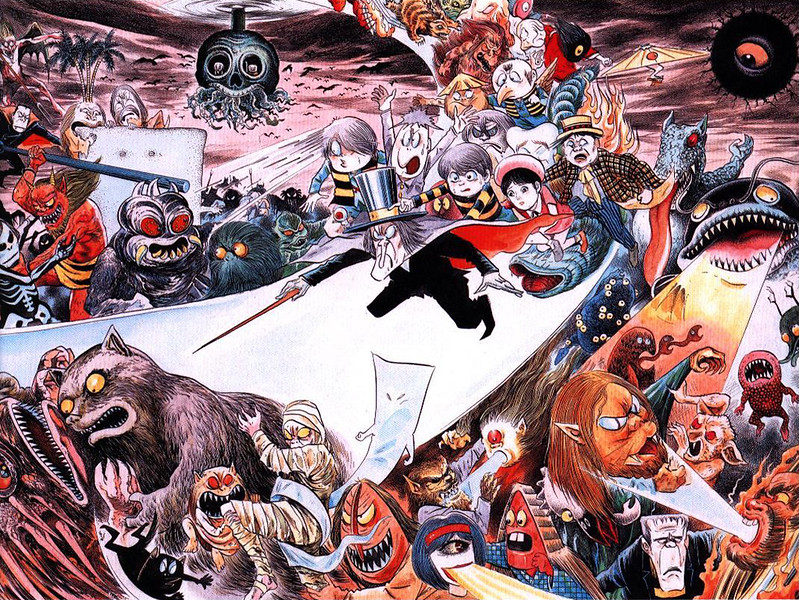

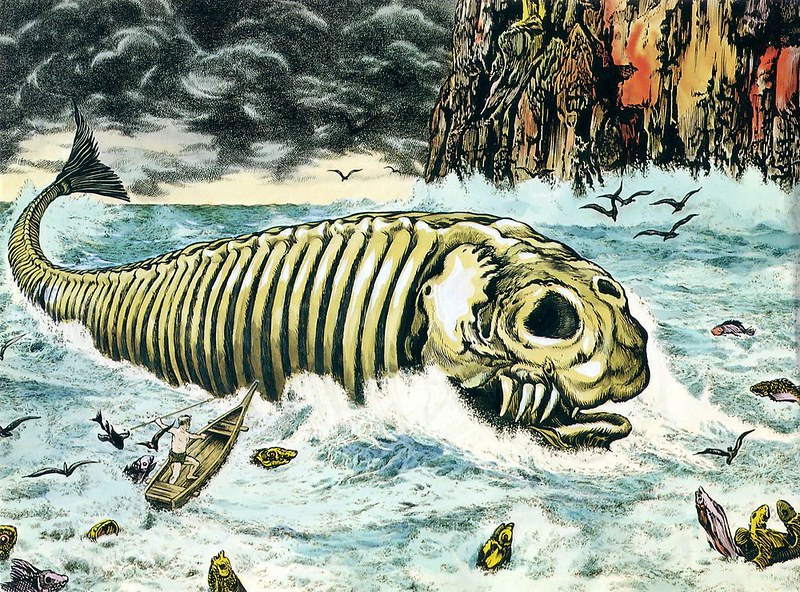
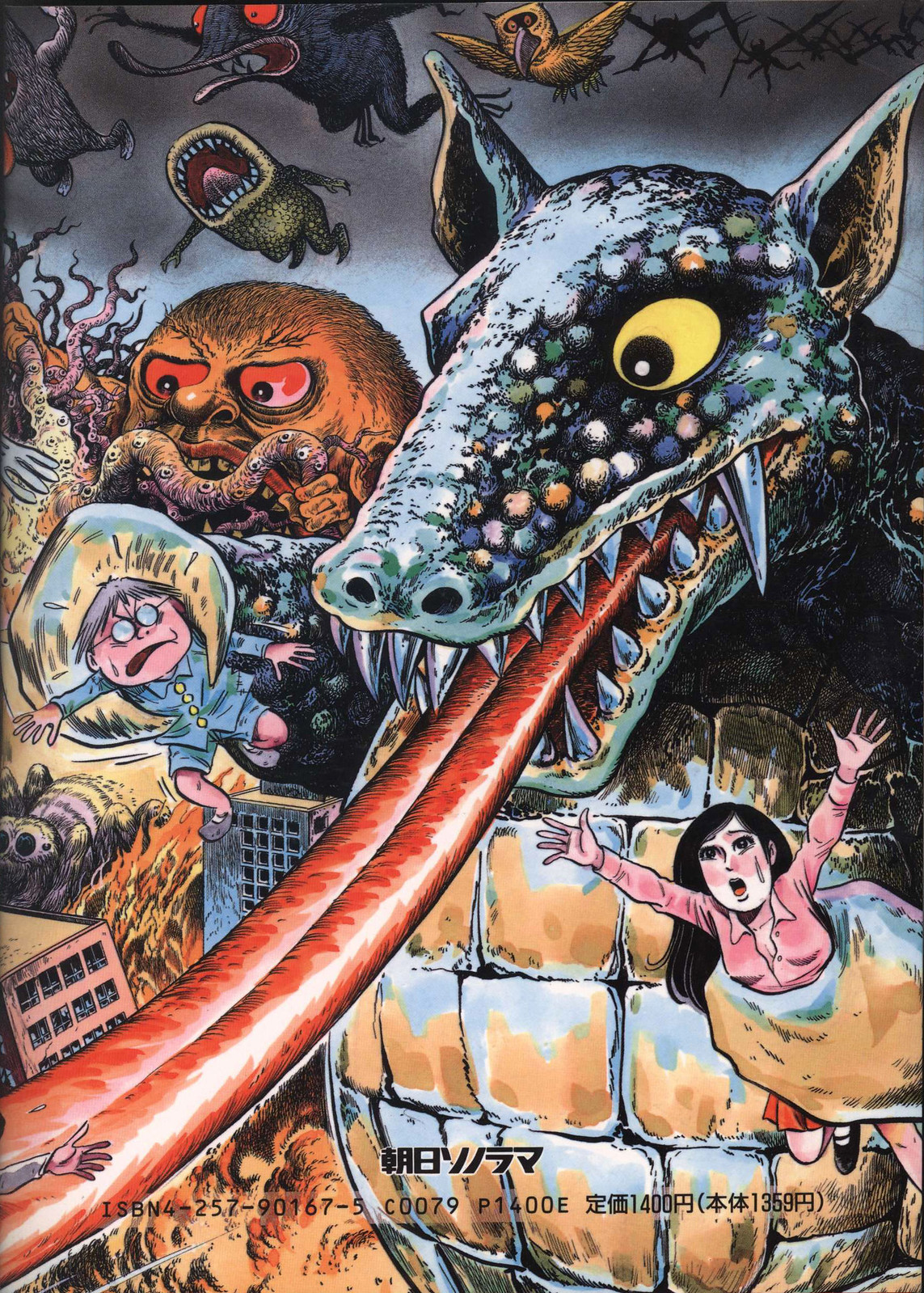
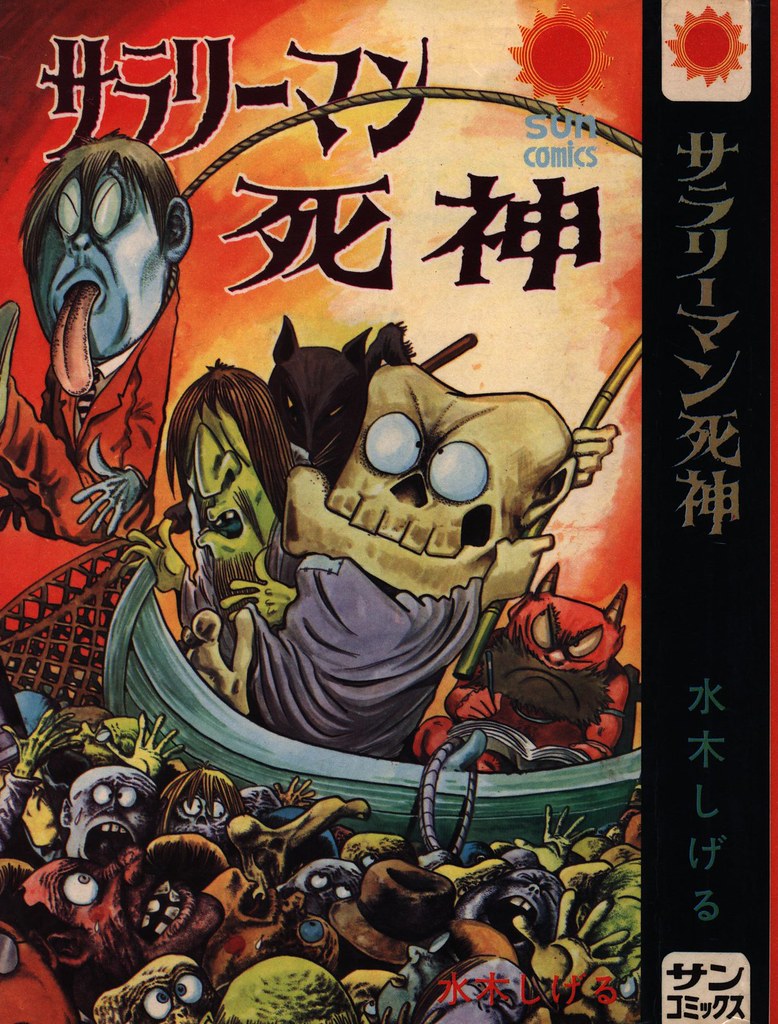

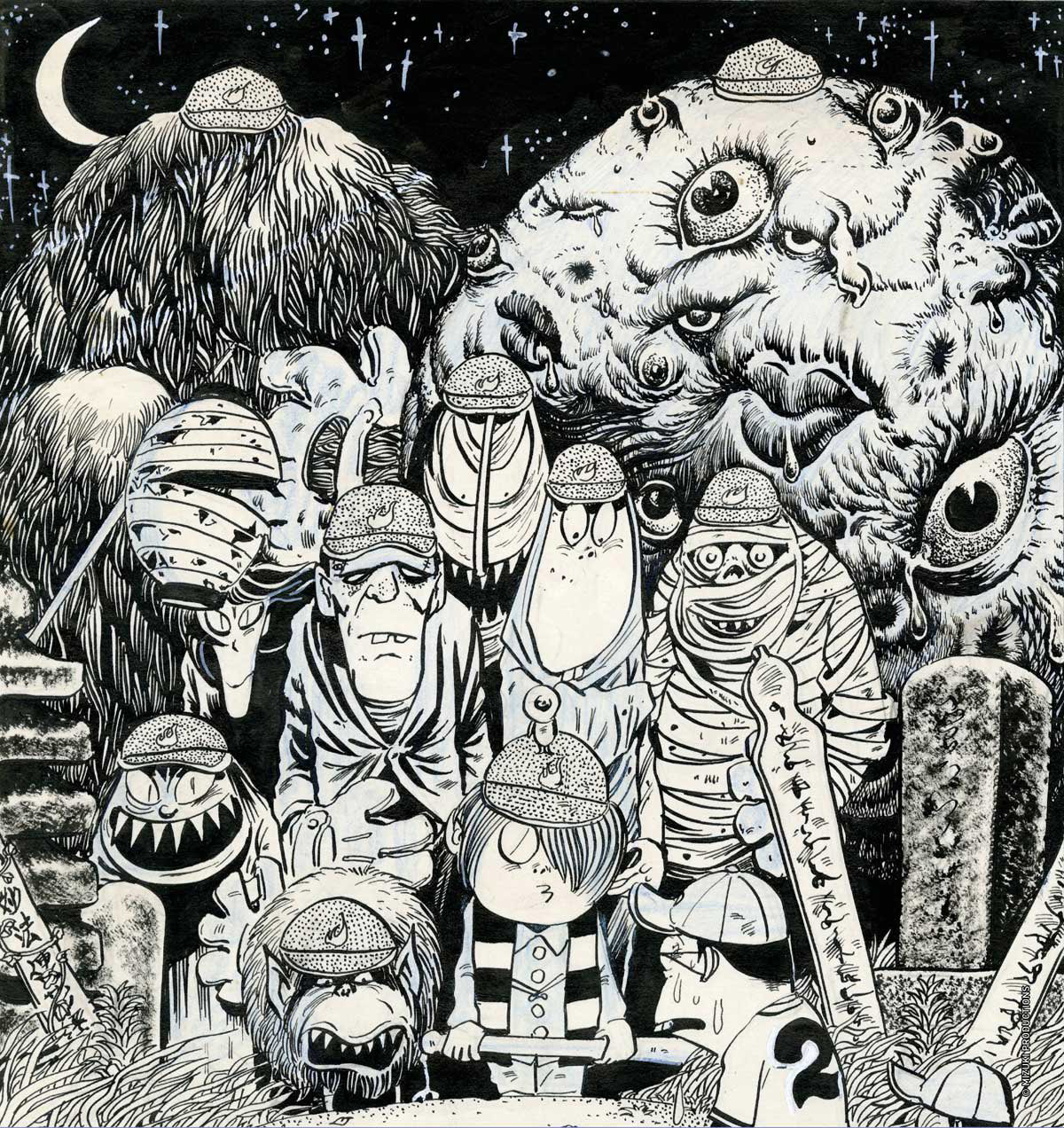



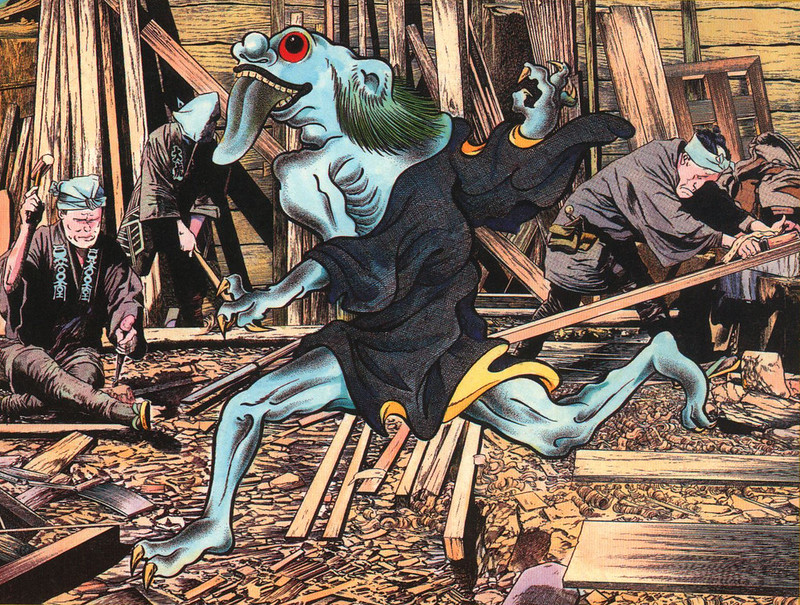
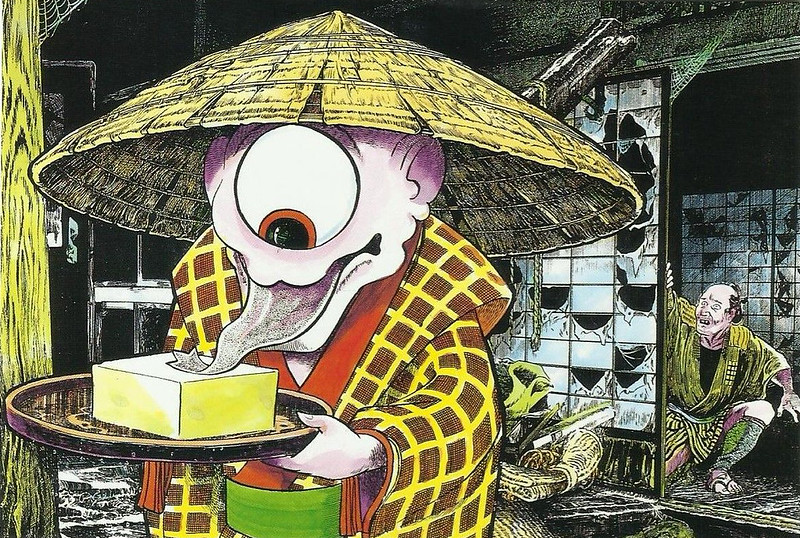



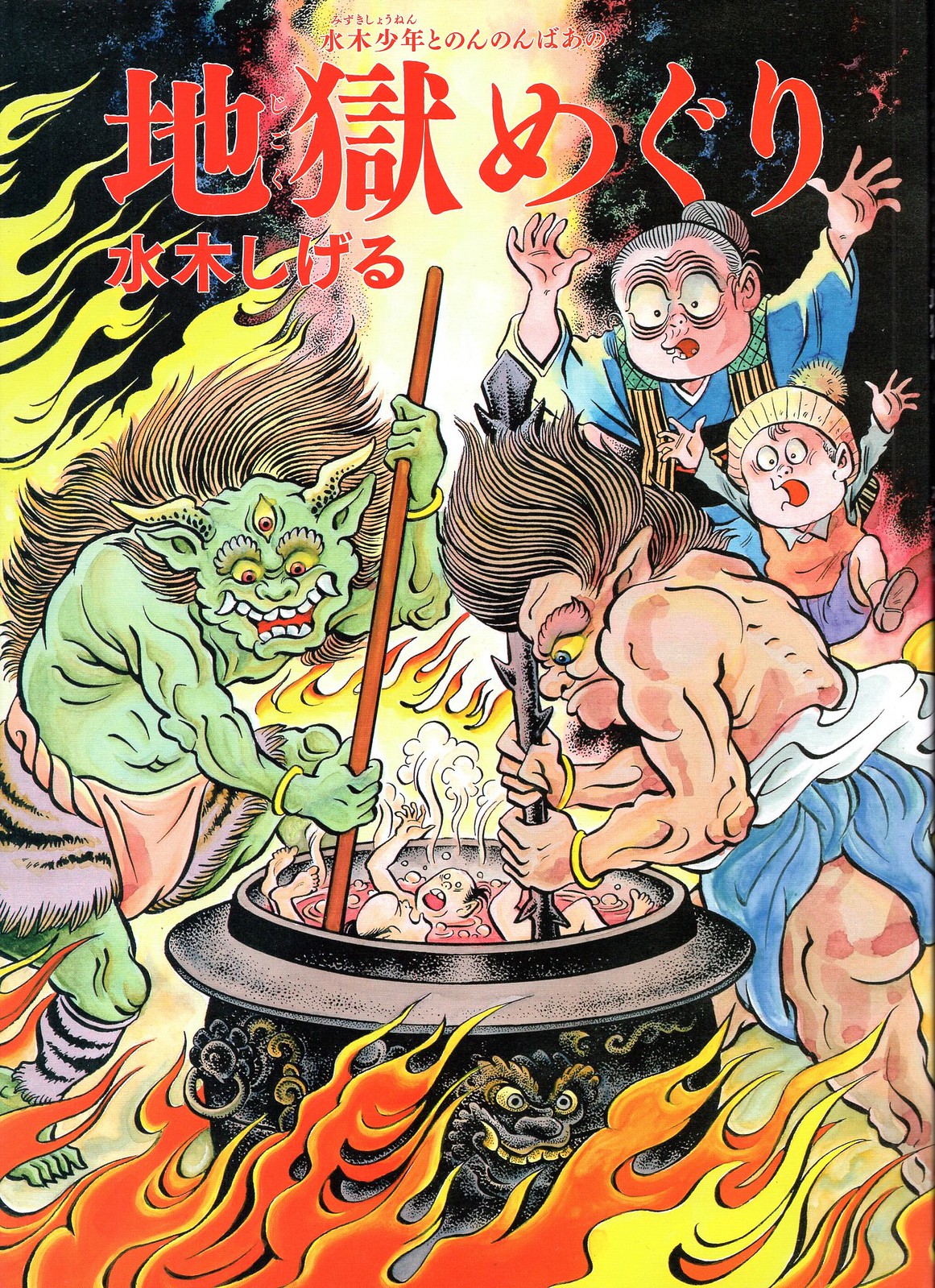

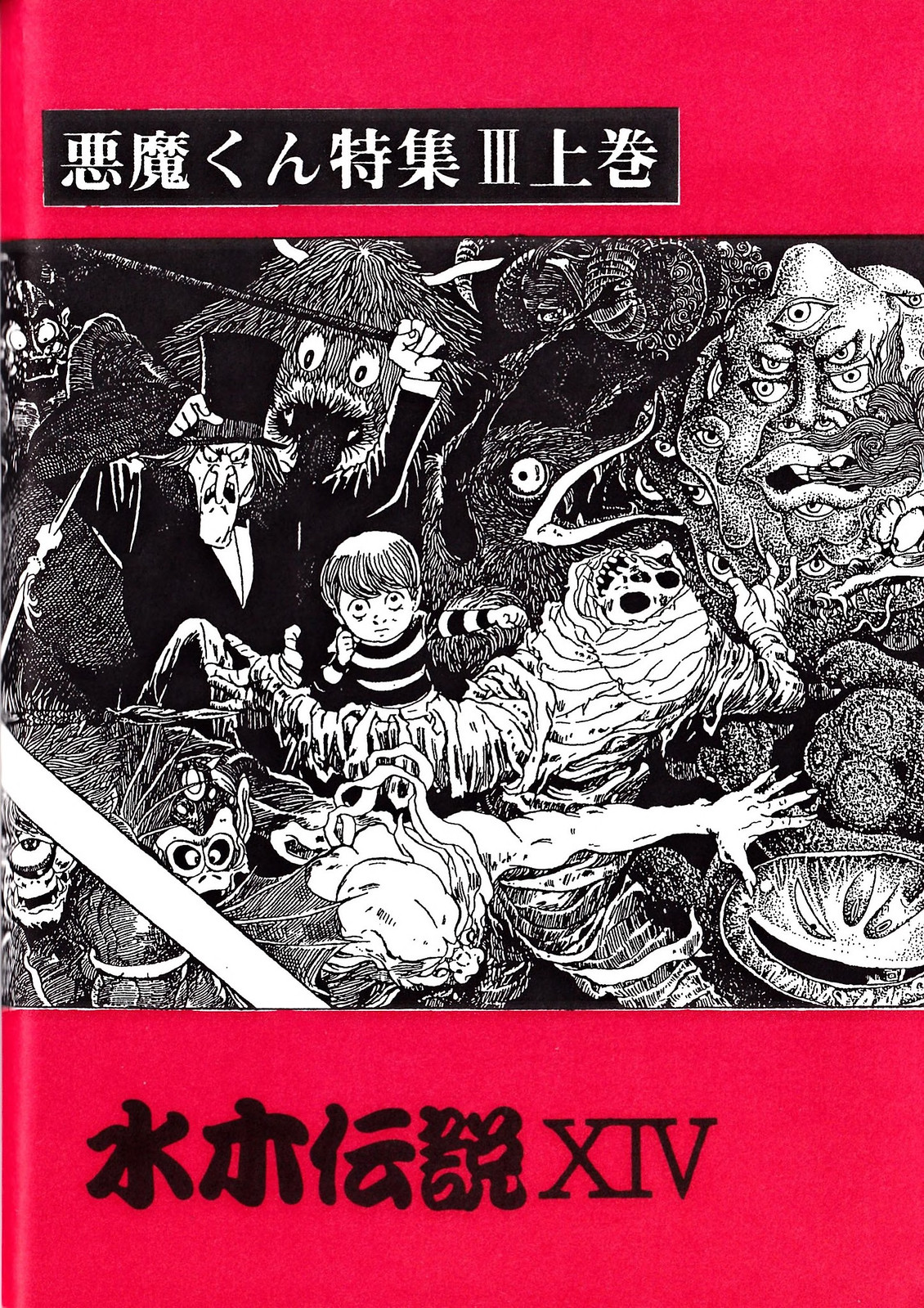



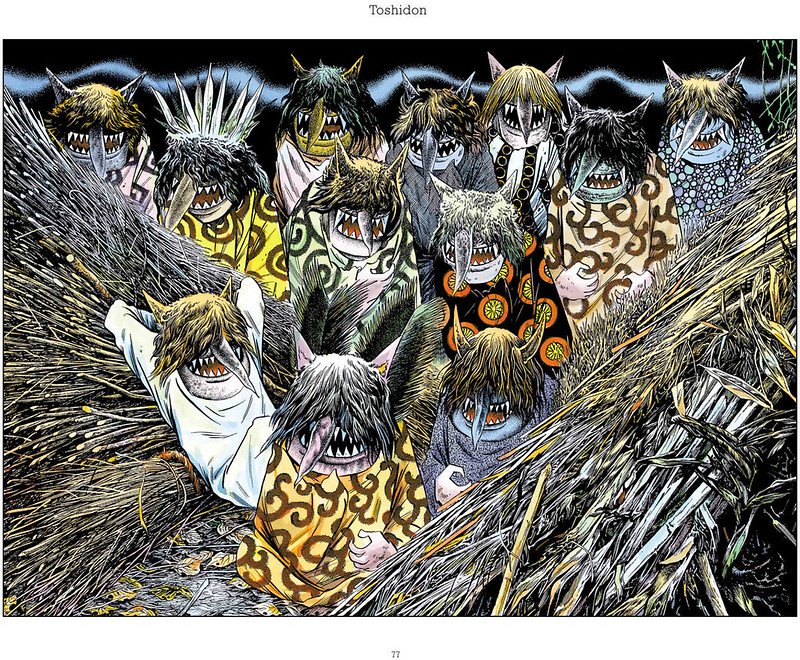




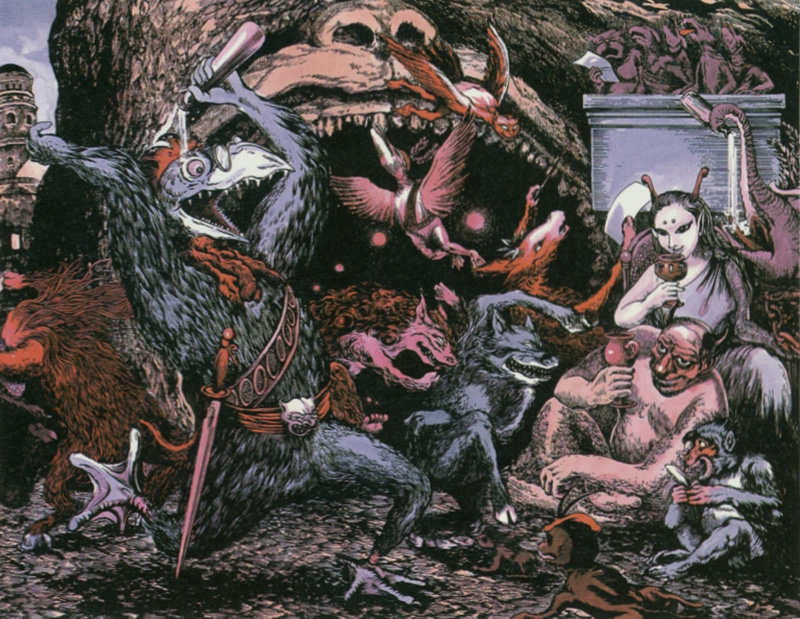
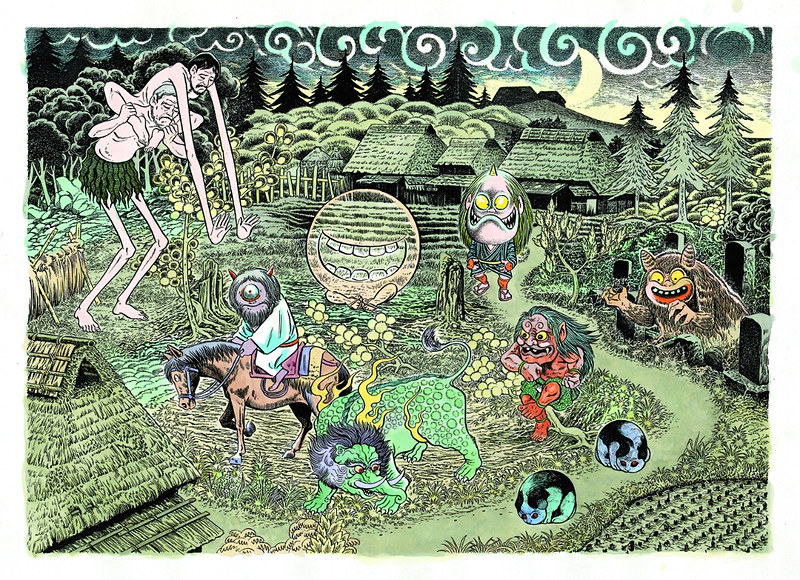
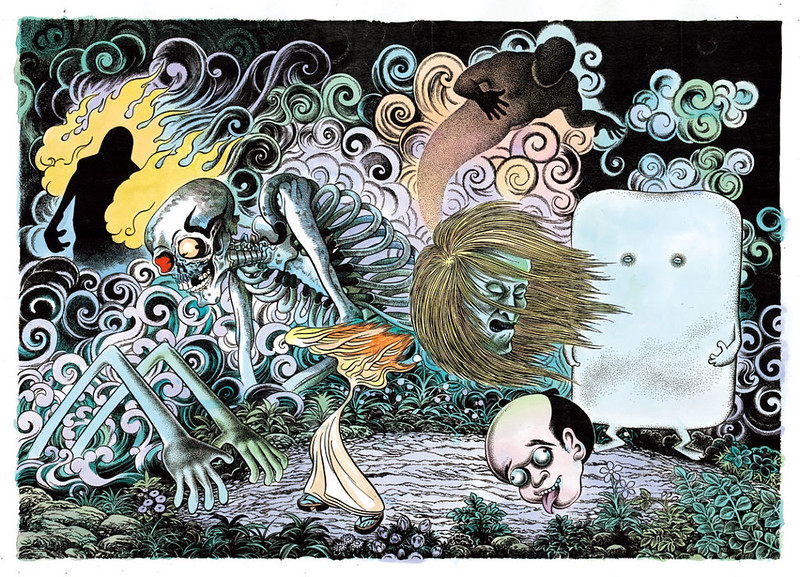


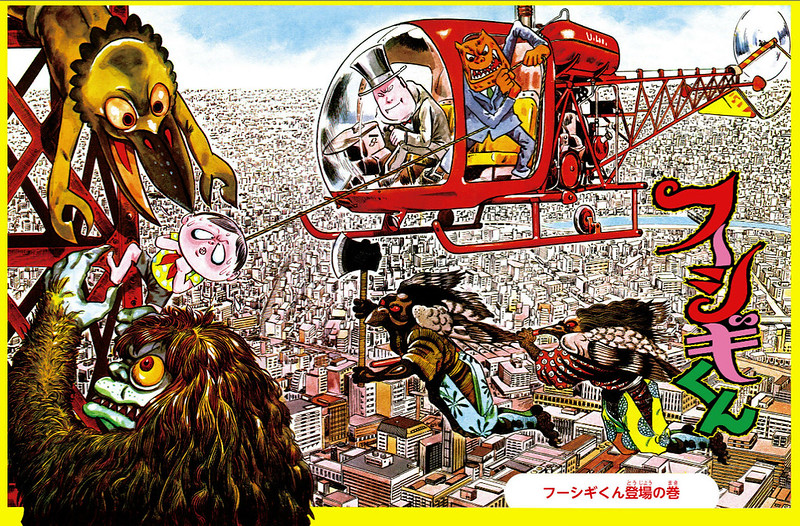











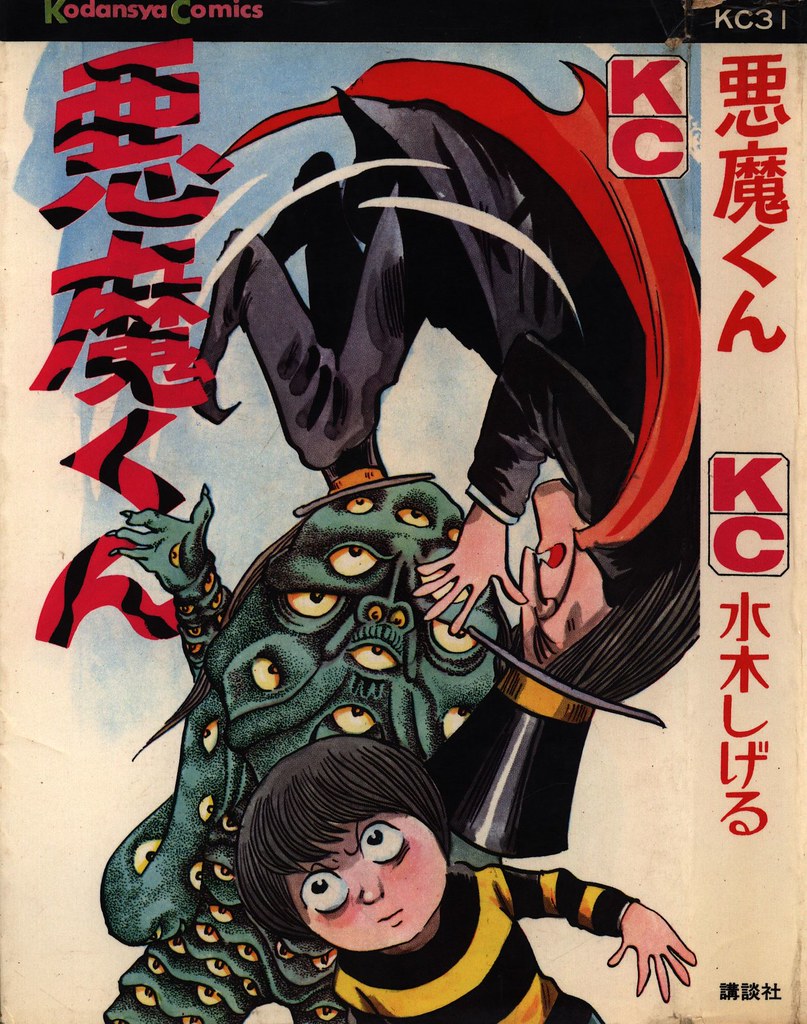



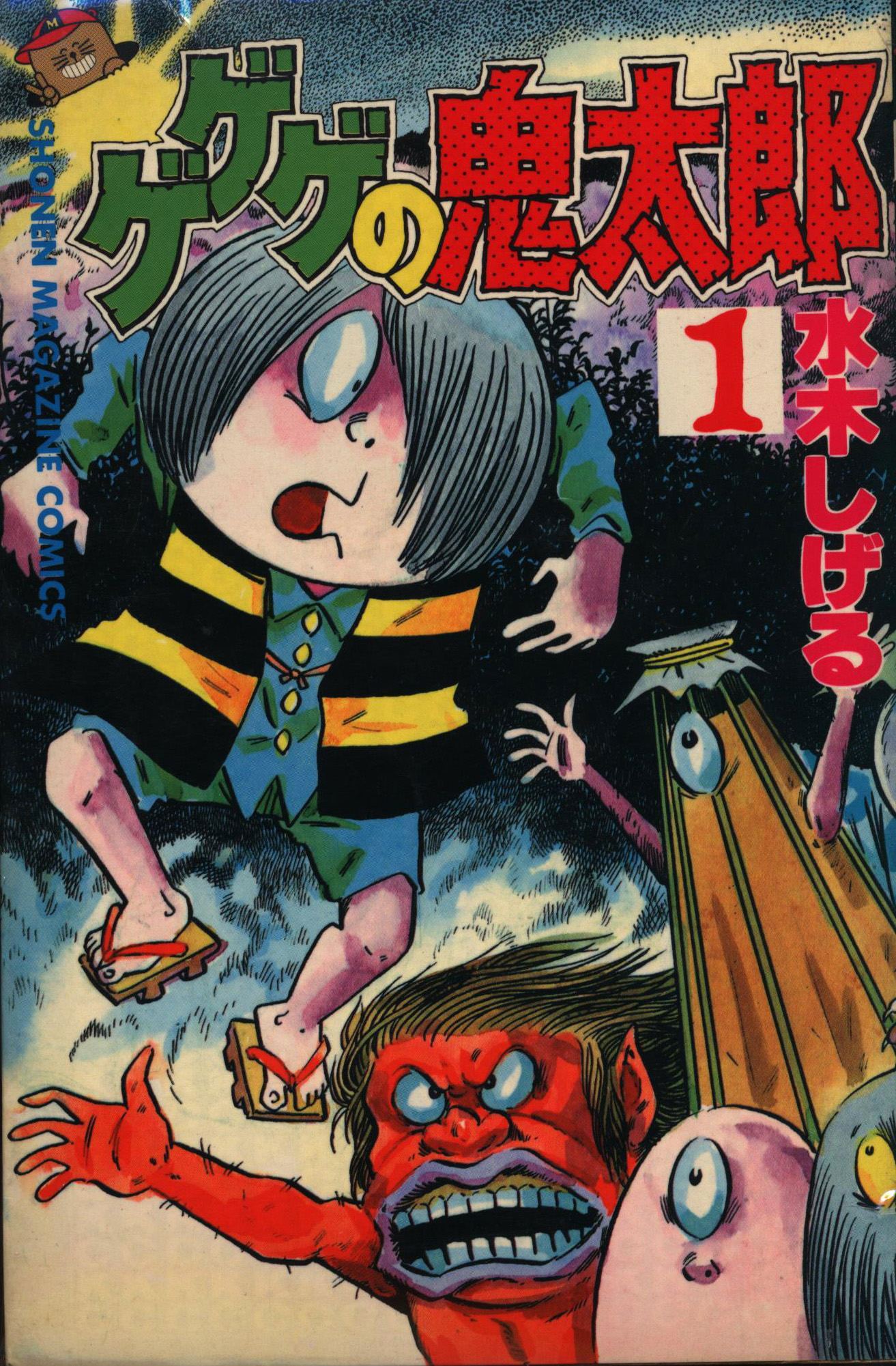



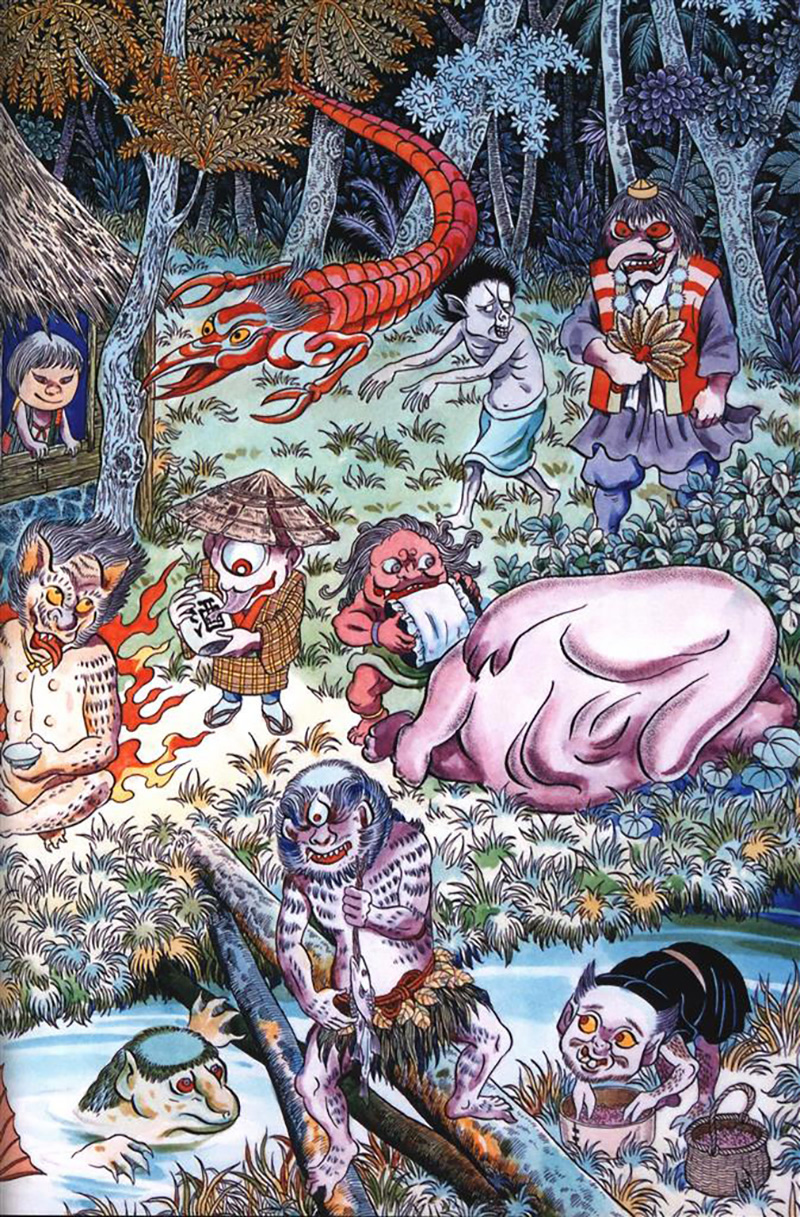

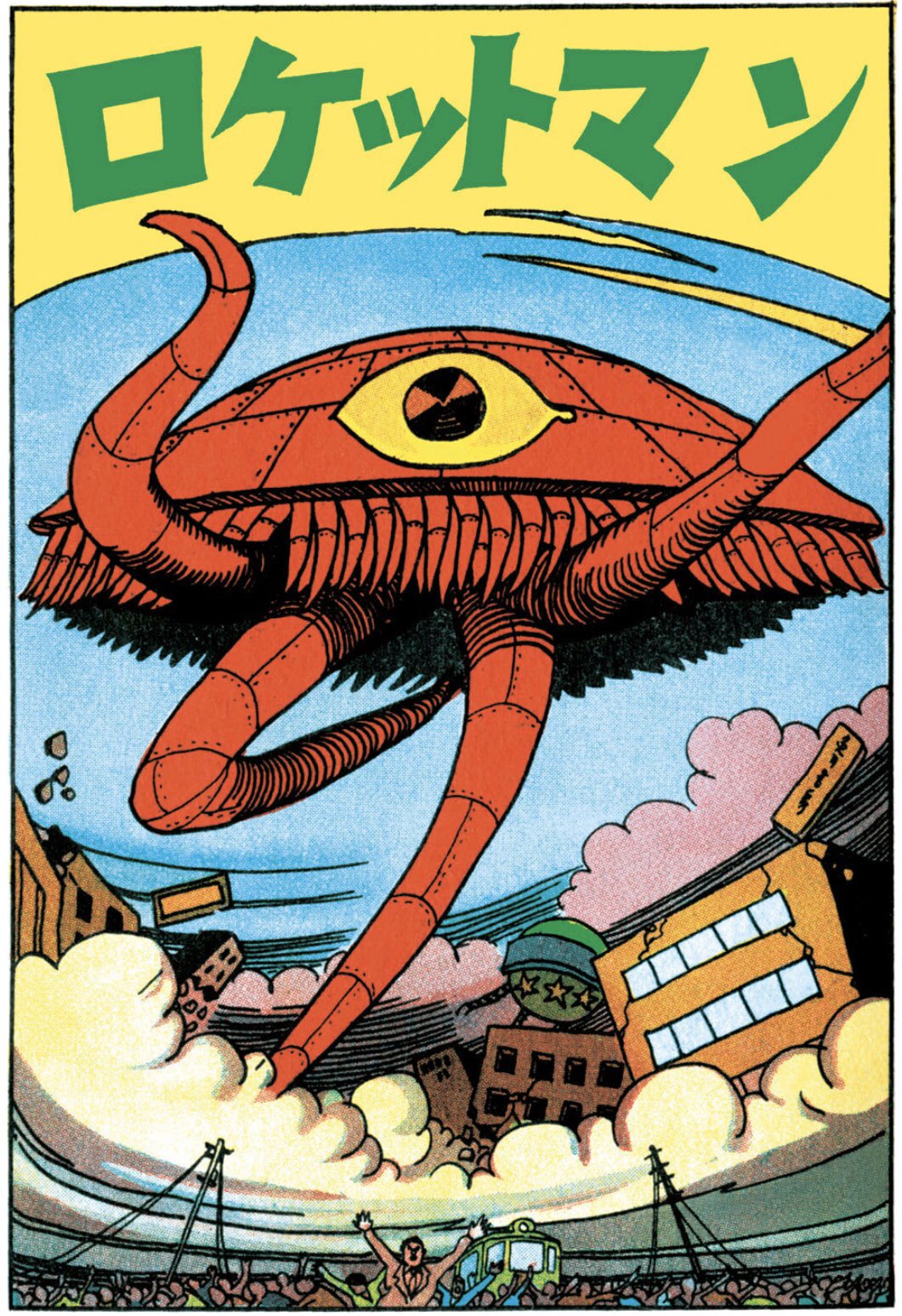


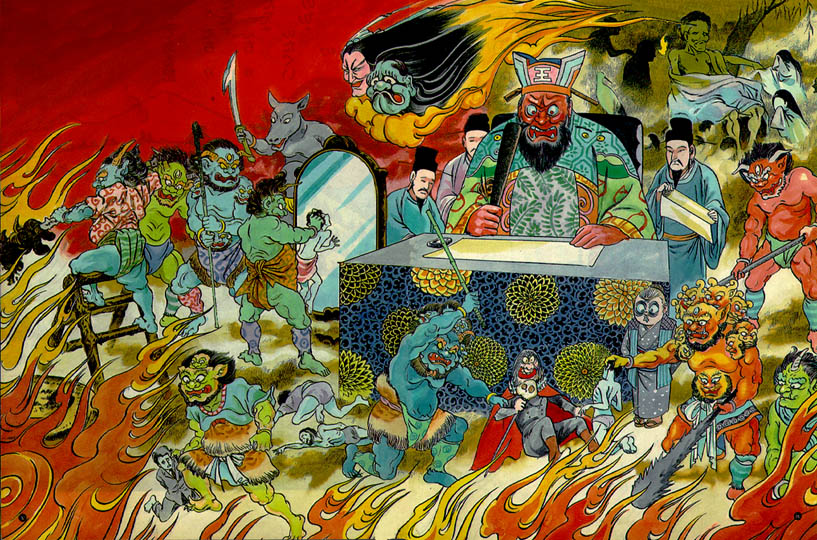









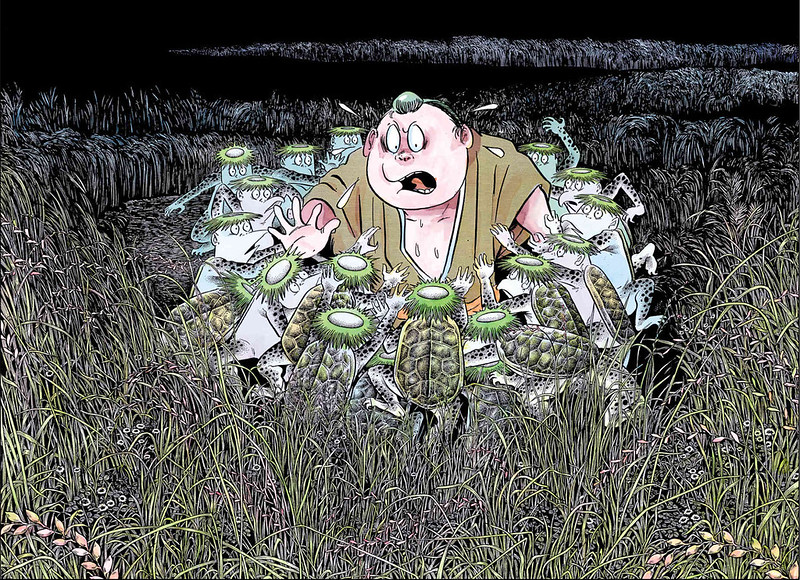

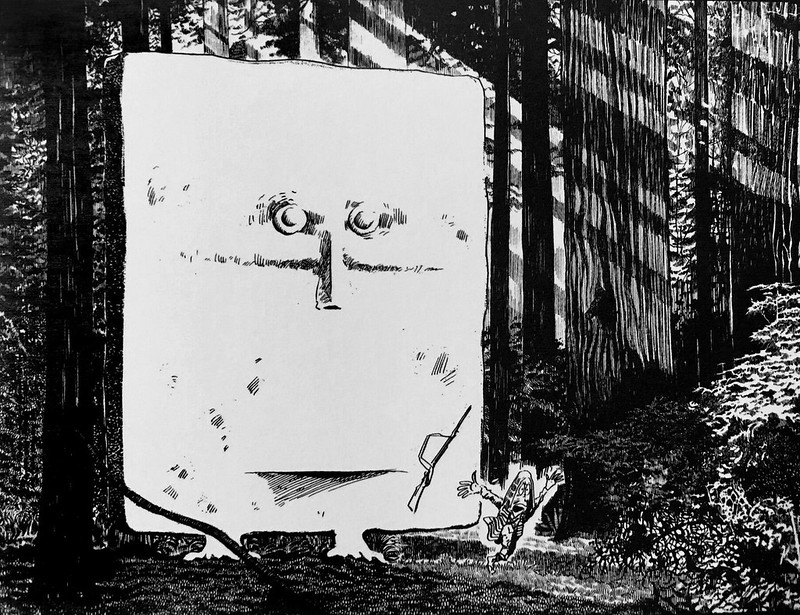




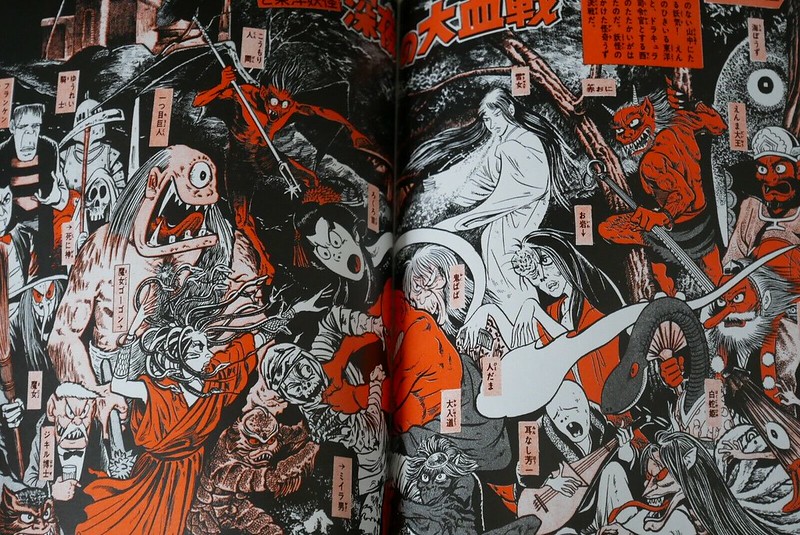
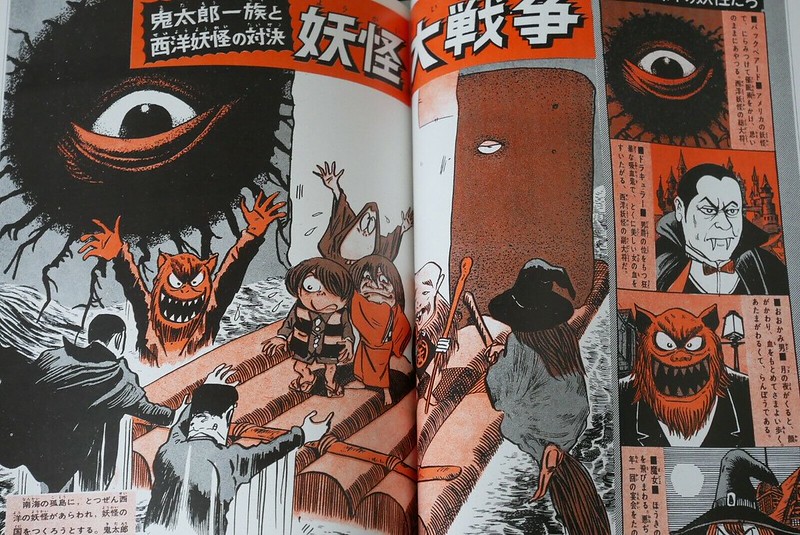
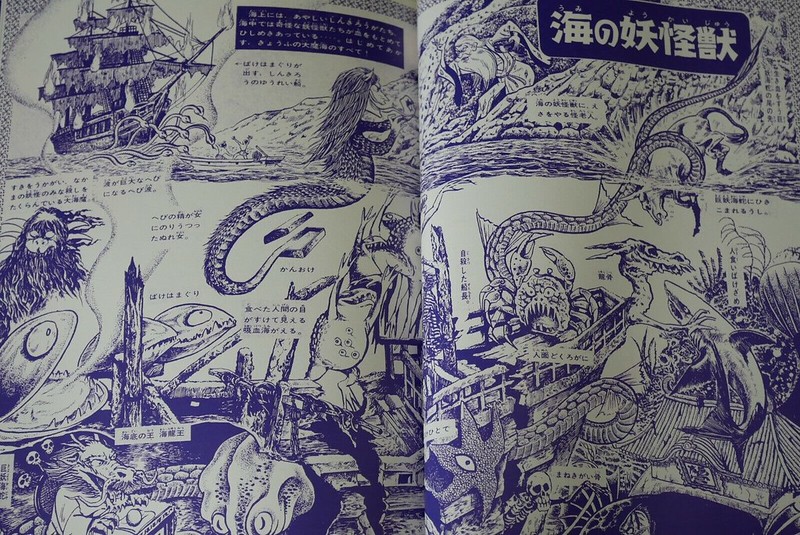

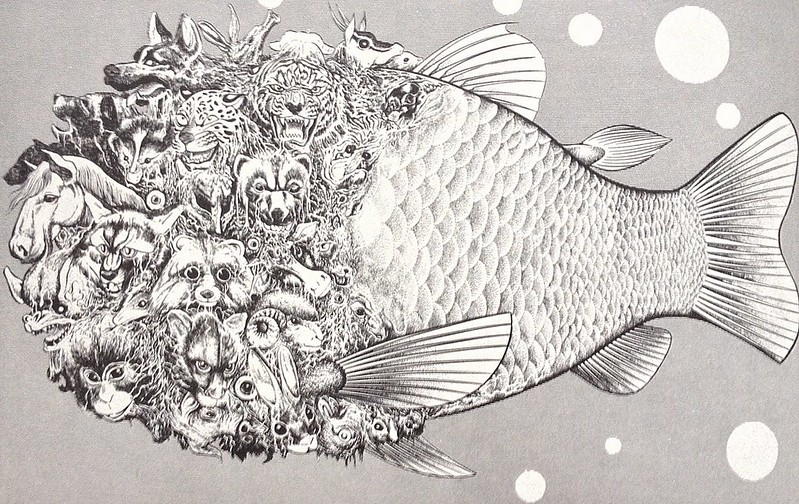


Previous Monster Brains posts sharing the work of Mizuki can be found below
Yokai / Mythological Creature Illustrations, 2002Illustrated Guide To Yokai Monsters, 2004 God of Pestilence Yokai, 1974 Yokai Illustrations
And finally, the first post on Monster Brains sharing the work of Mizuki in 2006.
1978: Star Trek: Adventure Gaming in the Final Frontier
1974 is an important year for the gaming hobby. It is the year that Dungeons & Dragons was introduced, the original RPG from which all other RPGs would ultimately be derived and the original RPG from which so many computer games would draw for their inspiration. It is fitting that the current owner of the game, Wizards of the Coast, released the new version, Dungeons & Dragons, Fifth Edition, in the year of the game’s fortieth anniversary. To celebrate this, Reviews from R’lyeh will be running a series of reviews from the hobby’s anniversary years, thus there will be reviews from 1974, from 1984, from 1994, and from 2004—the thirtieth, twentieth, and tenth anniversaries of the titles. These will be retrospectives, in each case an opportunity to re-appraise interesting titles and true classics decades on from the year of their original release.
—oOo— It is often forgotten that Star Trek: The Role Playing Game, published by FASA in 1982 was not the first Star Trek roleplaying game. It is often forgotten that Call of Cthulhu, published by Chaosium, Inc. in 1981 was not the first licensed roleplaying game. The very first licensed roleplaying game and the very first roleplaying based on Star Trek was Star Trek: Adventure Gaming in the Final Frontier, published Heritage Models, Inc. in 1978. It was best known for its miniatures and besides manufacturing fantasy miniatures for Dungeons & Dragons, it also produced miniatures for the rulesets it published, including both John Carter, Warlord of Mars: Adventure Gaming Handbook and Star Trek: Adventure Gaming in the Final Frontier. In the late seventies, it was a major company in the growing hobby market, rivalling TSR, Inc., but by the beginning of the eighties, it was out of business.
It is often forgotten that Star Trek: The Role Playing Game, published by FASA in 1982 was not the first Star Trek roleplaying game. It is often forgotten that Call of Cthulhu, published by Chaosium, Inc. in 1981 was not the first licensed roleplaying game. The very first licensed roleplaying game and the very first roleplaying based on Star Trek was Star Trek: Adventure Gaming in the Final Frontier, published Heritage Models, Inc. in 1978. It was best known for its miniatures and besides manufacturing fantasy miniatures for Dungeons & Dragons, it also produced miniatures for the rulesets it published, including both John Carter, Warlord of Mars: Adventure Gaming Handbook and Star Trek: Adventure Gaming in the Final Frontier. In the late seventies, it was a major company in the growing hobby market, rivalling TSR, Inc., but by the beginning of the eighties, it was out of business. Being published in 1978, means that Star Trek: Adventure Gaming in the Final Frontier is based upon just the two sources—the original Star Trek series from the sixties and Star Trek: The Animated Series. Consequently, this includes the inclusion of the Kzinti from the Star Trek: The Animated Series episode, ‘The Slaver Weapon’, which would mark the first inclusion of the Kzinti in a roleplaying game a full six years before the publication of The Ringworld Roleplaying Game by Chaosium, Inc. However, the roleplaying and play in Star Trek: Adventure Gaming in the Final Frontier is limited to landing missions, and there are no rules for starships or space travel whatsoever. The style of play emphasises exploration and especially combat, essentially ‘dungeon crawl’ or ‘sandbox’ style adventures or missions across planetary surfaces or inside alien structures, all played out over a hex grid. Despite this, the designer admonishes potential players that, “Combat should be the last resort of an officer of the Federation…” Even so, the majority of the rules are devoted to combat and if truth be told, Star Trek: Adventure Gaming in the Final Frontier is still more miniatures combat game than roleplaying game with rules primarily designed to necessitate the use, and of course, purchase of miniatures, all available from Heritage Models, Inc.
Play in Star Trek: Adventure Gaming in the Final Frontier primarily revolves around the Star Trek personalities, at least initially. Numerous members of the bridge crew and other crew aboard the Enterprise are listed, as well as numerous ‘villains’ such as the Klingon, Captain Koloth, and Sub-Commander Tal of the Romulan Star Empire. Just the basic stats though. There is no background given for any one of these personalities, let alone the Star Trek setting itself, so in coming to play or run Star Trek: Adventure Gaming in the Final Frontier, both player and Mission Master—the roleplaying game’s term for the Game Master—need to know the stetting and the characters. On the plus side, Star Trek is so baked into the cultural zeitgeist—and was in 1978—that anyone coming to Star Trek: Adventure Gaming in the Final Frontier should have more than a passing similarity to both, if not the nuances.
Star Trek: Adventure Gaming in the Final Frontier is divided into the Basic Game and the Advanced Game. The Basic Game covers the basics of Personalities, the basics of the rules and combat, and a Basic Game scenario. The Advanced Game includes its own scenario, rules for character creation, expanded combat rules, familiar Star Trek life forms and their creation, expanded equipment, guidelines for creating scenarios, and notes for the Mission Master. So, in the Basic Game, the players take the roles of the Personalities from original Star Trek series from the sixties and Star Trek: The Animated Series, the Bridge Crew and other members of the Crew. A Personality in Star Trek: Adventure Gaming in the Final Frontier is simply defined by his six abilities, all of which are self-explanatory bar one. That is Constitution, which works as a Personality’s Hit Points.
Captain James T. Kirk
Strength 13 Dexterity 14 Luck 15
Mentality 14 Charisma 16 Luck 13
Command
Phaser II
Communicator
Class 2 Hand-to-Hand
Plus 2 to Initiation
Plus 5 in Hand-to-Hand
Mechanically, Star Trek: Adventure Gaming in the Final Frontier uses the rules from Space Patrol, published by Gamescience in 1977. If a player wants his Personality to undertake an action, he rolls three six-sided dice and if rolls under the appropriate ability, his Personality succeeds. Luck is used as a general saving throw. Combat takes place over Turns of a minute long, divided into Action Phases of two to five seconds long. Each Action Phase consists of four steps—Decision, Initiation, Execution, and Record-Keeping. Of these, Initiation is actually initiative, which is done in descending order of Dexterity. Decision is when the players decide what their Personalities do, and Execution is when their Personalities do their actions. This includes a full move, half move and attack, attack, reload, or stand up or lie down. Hand-to-Hand combat is handled through opposed rolls of a singe six-sided die plus modifiers. Hand-to-Hand and modifiers above twelve and below nine for Strength and Dexterity for the attacker, and Hand-to-Hand and modifiers above twelve and below nine for Luck for the defender. In Ranged Combat, the attacker and the defender again one die each. For the attacker, the player cross-references his Personality’s Dexterity with the range and roll under the result. If hit, the defending Personality’s player applies modifiers above twelve and below nine for Luck and the resulting number subtracted from the damage, the end result deducted from the defender’s Constitution. This can reduce the damage to nothing, but weapons can also stun. Creatures do not have the same abilities as the Personalities and characters, but just a simple Ability Rating.
The Basic Game also includes rules for basic equipment and even includes an example of play. The scenario in the Basic Game is ‘The Shuttlecraft Crash’. Essentially, this is a rerun of the classic episode, ‘The Galileo Seven’ in which the Personalities have crash-landed their shuttle and must search the area for dilithium deposits in the face of attacks by large, spear-wielding humanoids and other natural hazards. Strangely, the Advanced Game begins with the second scenario in Star Trek: Adventure Gaming in the Final Frontier rather than the advanced rules. ‘The Slaver Ruins’ is partially based on ‘The Slaver Weapon’ episode of Star Trek: The Animated Series and sees the Player Characters investigate some ruins and try and stop the ancient technology hidden there from falling into Kzinti hands. Although both scenarios have strong exploratory elements, neither is really a roleplaying scenario by today’s standards since they consist of objectives for the Player Characters to achieve within a limited space and possess little in the way of story or plot development.
The Advanced Game introduces character creation. The default species for Player Characters is Human, but the list of ‘Familiar Star Trek Life Forms’ includes various playable species, such as Andorians, Caitians, and Vulcans alongside Tribbles, Horta, and Sehlats. Abilities are rolled on three six-sided dice and Player Characters have a one percent chance of possessing a single Psionic ability. Psionic ability rolls use the Mentality ability. In addition, a Player Character also has the Size and Movement abilities, the former modified by a roll of a twenty-sided die, the latter by the Player Character’s Strength and items carried. Besides the ‘Familiar Star Trek Life Forms’ lists there are rules for creating creatures as well as a greatly expanded list of equipment. In terms of characters, there are no rules for skills or progression or rank, so no sense of progression in the roleplaying game, at least mechanically.
Unsurprisingly, the Advanced Game also expands the rules for combat. So, Initiation is now a die roll modified by Dexterity and weapons now include an Initiation modifier. Weapons now take into account rate of fire, rounds, reload time, and so on. There are rules too for armour and shielding, from chainmail and kite shield all the way up to energy and kinetic shields and the Klingon armour vest. Grenades the effects of Phaser weapons on overload as well as high explosive, sonic, and photon types.
Whilst the introduction to both Star Trek and roleplaying in Star Trek: Adventure Gaming in the Final Frontier can be best described as rudimentary, the advice for the Mission Master in terms of creating her own scenarios and notes is surprisingly good, amounting to roughly three pages between them. The Mission Master is advised to give her creatures motivations—such as the Horta protecting her young—and several scenarios are discussed, such as interstellar police and space salvage. There is even the suggestion that the players roleplay Klingons or Romulans instead! The notes cover both how to take inspiration from the source material and how not to, warns the Mission Master to be a fair arbiter and designer of scenarios, and lastly warns that if the Mission Master fails as a script writer, then just like Star Trek itself, her game will get cancelled!
Physically, it is difficult to judge Star Trek: Adventure Gaming in the Final Frontier, since what is being reviewed is a facsimile rather than an original copy of the game. On that basis, it is surprising to see that it has an index, but there are no illustrations and the two maps, one for each scenario, are serviceable rather than attractive. However, on that basis, Star Trek: Adventure Gaming in the Final Frontier very much needs an edit, because otherwise, no one will look at Commander Spack quite the same way ever again. The writing in general is concise and easy to understand for anyone coming to the hobby for the first time.
Another surprise is that the facsimile of Star Trek: Adventure Gaming in the Final Frontier includes two extra articles, both of which are reprinted from Different Worlds magazine and are the only coverage that the roleplaying game received. ‘Kirk On Karit 2’ (Different Worlds Issue 4, August 1979) by Emmet F. Milestone is primarily a play report of a scenario that he wrote and ran at DunDraCon IV, but it includes an overview of the game plus rules for romantic entanglements, which of course, plays a big part in James T. Kirk’s activities, as well as other personalities in the series. Of more use is ‘Star Trek – Beyond the Final Frontier’ (Different Worlds Issue 18, January 1982), as it expands the rules and arguably rounds them out. Paul Montgomery Crabaugh’s article covers rolling for Player Character species, provides a Rank and Experience Point table as well as discussing Rank within the game, and adds rules for skills and shipboard assignments, including starship type and department. Lastly there are basic rules for creating planets and their populations and level of technology, as well as guidelines for travel at Warp speed. These are well thought out and greatly flesh out Star Trek: Adventure Gaming in the Final Frontier, making it much more of a roleplaying game than the miniatures combat with roleplaying elements it was published as. However, Paul Montgomery Crabaugh’s greatly needed article came four years too late. FASA would published its highly regarded Star Trek: The Role Playing Game that same year as Crabaugh’s article and it would include just about everything that article did. Plus of course, it had photographs from the series and more importantly, rules for starship combat.
Star Trek: Adventure Gaming in the Final Frontier dates from the early days of the hobby when its ties from wargaming had yet to be truly cut. Thus, this is far more of a wargame than a true roleplaying game, although there are rudimentary roleplaying elements present. The emphasis on combat also means that Star Trek: Adventure Gaming in the Final Frontier is a poor Star Trek game, although in the hands of a good Mission Master and players knowledgeable of the source material, that could very much change. By modern standards, Star Trek: Adventure Gaming in the Final Frontier is not a good, licensed roleplaying game, not really satisfying the interest of the average Star Trek fan, and neither is it a good roleplaying game. Yet it is not truly terrible, nor is it unplayable, even today. If someone was to run this at a convention as a wargame, complete with miniatures and terrain, it would be accepted as a slice of nostalgia. As a roleplaying game, it be less likely to be accepted as something that was playable. Then again, even in 1978, it is likely that Star Trek: Adventure Gaming in the Final Frontier would have been regarded as no more than a serviceable game. Of course, we have since been spoiled with numerous and better Star Trek roleplaying games since 1978, but Star Trek: Adventure Gaming in the Final Frontier deserves at least to be remembered as the first Star Trek roleplaying game and the first licensed roleplaying game.
Friday Fantasy: DCC Day 2022 Adventure Pack
 As well as contributing to Free RPG Day every year Goodman Games also has its own ‘Dungeon Crawl Classics Day’, which sadly, is a very North American event. The day is notable not only for the events and the range of adventures being played for Goodman Games’ roleplaying games, but also for the scenarios it releases specifically to be played on the day. For ‘Dungeon Crawl Classics Day 2022’, which took place on Saturday, July 16th, 2022, the publisher released not one, not two, but three booklets. Two of these were specifically for the Dungeon Crawl Classics Role Playing Game—the supplement, Dungeon Crawl Classics Day: The Book of Fallen Gods, and the scenario, Dungeon Crawl Classics Day #3: Chanters in the Dark. The third, DCC Day 2022 Adventure Pack, is a duology of scenarios for both the Dungeon Crawl Classics Role Playing Game and Mutant Crawl Classics Roleplaying Game – Triumph & Technology Won by Mutants & Magic. Both scenarios are designed for Player Characters of Second Level, both are nicely detailed, and both can be played in a single session, but neither should take no longer than two sessions to complete.
As well as contributing to Free RPG Day every year Goodman Games also has its own ‘Dungeon Crawl Classics Day’, which sadly, is a very North American event. The day is notable not only for the events and the range of adventures being played for Goodman Games’ roleplaying games, but also for the scenarios it releases specifically to be played on the day. For ‘Dungeon Crawl Classics Day 2022’, which took place on Saturday, July 16th, 2022, the publisher released not one, not two, but three booklets. Two of these were specifically for the Dungeon Crawl Classics Role Playing Game—the supplement, Dungeon Crawl Classics Day: The Book of Fallen Gods, and the scenario, Dungeon Crawl Classics Day #3: Chanters in the Dark. The third, DCC Day 2022 Adventure Pack, is a duology of scenarios for both the Dungeon Crawl Classics Role Playing Game and Mutant Crawl Classics Roleplaying Game – Triumph & Technology Won by Mutants & Magic. Both scenarios are designed for Player Characters of Second Level, both are nicely detailed, and both can be played in a single session, but neither should take no longer than two sessions to complete.DCC Day 2022 Adventure Pack opens with ‘Incident at Toad Fork’, a scenario for the Dungeon Crawl Classics Role Playing Game written by Brendan Lasalle. This returns to the Appalachian-style fantasy setting of The Shudder Mountains, first seen Dungeon Crawl Classics #83: The Chained Coffin and more recently compiled in Dungeon Crawl Classics #83: The Chained Coffin anthology. Consequently, the scenario has a strong sense of the rural versus the urban, the backwoods culture versus the sophisticated manners of the city, the distrust of the latter by the former, and the feeling that them there city folk are invariably out to bamboozle the good folk of The Shudder Mountains.
The scenario opens with the Player Characters invited to the Harvest Moon Dance, an important annual event when all of the Shudfolk from the communities across The Shudder Mountains come together. It is normally a joyous affair, with plenty of dancing and music, but this year is different. A strange shadow is cast over the activities as several of the young men suddenly bolt, running pell-mell into the surrounding woods, oblivious to all entreaties. The Elders entreat the Player Characters to go after them and they quickly encounter strange glamours and a representative of one the devil which competes for Shudfolk souls. This is a fun roleplaying encounter for the Judge to portray, the NPC being akin to the charming and seductive Mister Dark from the film, Something Wicked This Way Comes, as portrayed by Jonathan Pryce (or in this case, Vincent Price). Overall, reminiscent perhaps of Halloween, but set way in the mountains with a Hillbilly sensibility, if the Judge has not yet run Dungeon Crawl Classics #83: The Chained Coffin, then this is an entertaining and engaging adventure to add to the campaign setting.
Marzio Muscedere’s ‘The Last Life Guardian’ is the second scenario. In this adventure for Mutant Crawl Classics Roleplaying Game, members of the Player Characters’ village have learned a terrifying tale of horror and hope from a dying outland trader. He told them that a Pure Strain Human wizard with the ability to heal and even bring the dead back to life is being held prisoner by savage mutants within a time-ravaged superstructure of the Ancient Ones. The village Rememberers—the wisest of the villagers—have said that the trapped wizard must be none other than a fabled Life Guardian, a surviving member of an ancient pre-disaster order sworn to heal and protect mankind. Consequently, he must be rescued. Which of course, as village’s Seekers, those that go out and search for technology and knowledge of the Ancients and protect the villagers from outside threats, is a task for the Player Characters.
Once at the site of the time-ravaged superstructure, both Seekers and their players will quickly realise one fact each. The Seekers that even the lake is artificial and their players, what with the ruins of café alongside the lake and the tubes curling all over the place, that it is actually a former waterpark! Part of the fun of the scenario is in recognising this fact, as is discovering that it is home to a tribe of fishmen! So what you have is not-Deep Ones at the deep end of the pool and they are not happy with the presence of the Seekers. As well as dealing with the not-Deep Ones, there is still a decent bit of exploration and investigation to conduct, with only a relatively small bit of roleplaying at the scenario’s end. The various locations are nicely detailed, and a lot of thought has gone into twisting a simple waterpark into an aquatic den of danger in Terra A.D. Especially the zombie which appears if the Seekers are just that too curious! Primarily an exploration and combat scenario, the isolated location for ‘The Last Life Guardian’ makes it easy to drop into a campaign, with success granting the Player Characters a potentially useful campaign reward rather than personal ones.
Physically, DCC Day 2022 Adventure Pack is decently done. The artwork is fun and the maps clear. The map for ‘The Last Life Guardian’ though will need careful examination by the Judge as it is a little busy. Both scenarios are well written and easy to read.
DCC Day 2022 Adventure Pack contains two entertaining scenarios. ‘The Last Life Guardian’ makes a great deal from the one location for the Mutant Crawl Classics Roleplaying Game – Triumph & Technology Won by Mutants & Magic, but ‘Incident at Toad Fork’ for the Dungeon Crawl Classics Role Playing Game and specifically, The Shudder Mountains, is a fun, fast-paced Hillbilly horror scenario which will want to make the Judge take a closer look at the Appalachian-style fantasy of Dungeon Crawl Classics #83: The Chained Coffin—if he has not already.
Rural Ruminations
 Maps form such a fundamental part of our gaming experience. We explore them. We journey across them. We delve into them. We defend them. We attack them. We draw them. We create stories using them. We have been gaming maps for centuries, whether it is to conduct wargames like Kriegsspiel or H.G. Wells’ Little Wars, or more recently explore great dungeons such as B2 Keep on the Borderlands or sprawling sandboxes such as X1 Isle of Dread, or even create a community and its history with a game like The Quiet Year. There is also something else that we can do with maps and that is contemplate, and it is something that Paths does. Designed and drawn by the British Children’s Laureate, children’s book illustrator and author, and political cartoonist, Chris Riddell, Paths is the first game to be published by Betonmond. Or rather it is the first game published by Betonmond that is not a game, although it could be if you wanted.
Maps form such a fundamental part of our gaming experience. We explore them. We journey across them. We delve into them. We defend them. We attack them. We draw them. We create stories using them. We have been gaming maps for centuries, whether it is to conduct wargames like Kriegsspiel or H.G. Wells’ Little Wars, or more recently explore great dungeons such as B2 Keep on the Borderlands or sprawling sandboxes such as X1 Isle of Dread, or even create a community and its history with a game like The Quiet Year. There is also something else that we can do with maps and that is contemplate, and it is something that Paths does. Designed and drawn by the British Children’s Laureate, children’s book illustrator and author, and political cartoonist, Chris Riddell, Paths is the first game to be published by Betonmond. Or rather it is the first game published by Betonmond that is not a game, although it could be if you wanted.Paths consists of fifty-two, large one-hundred-and-twenty-five by eighty-five-millimetre cards. Each depicts a landscape crisscrossed by one or more paths. A steep path leads up a hill to a round tower with a single door. A statue of a mermaid sits in the middle of a plaza around which stand a pyramid, a column, and other features. Paths cut through tunnels in the hills. A narrow path joins a junction surrounded by tall, narrow houses. A village sits atop a cliff overlooking a tower below. A field is divided by several routes, but leaves a single tent isolated. An abyss is encircled by the paths. A great viaduct crosses over a valley path. Paths connect to steps that descend to a single platform over a chasm or seemingly connect at random underneath a house that hangs from a wall. Who lives in the tower? Who was the mermaid? What lies in the tunnels? Who lives in the village and where does the narrow path lead? Why is the village higher than the tower? Who lurks in the abyss? What is the platform over the chasm used for? Who lives in the home hanging from the wall? These are just some of the questions that the cards in Paths provoke.
All of the cards are beautifully bucolic and are designed to form a grid, depicting an ever-greater area and range of terrain. As a deck they can be shuffled, cards drawn and laid out to form a whole map, and then done again and again to create new maps each time. Paths suggests that two cards be selected to mark the beginning and the end of a route, and then cards be drawn to map out the route between them, whether direct or meandering. The participant is encouraged to examine each card, asking what it makes him think of or how he feels? The process is intended to be contemplative, even meditative, the participant almost taking a walking holiday across his loving room table.
Lastly, Paths turns the participant into a player and the map cards into a game. It is suggested the map is built collaboratively with perhaps one player as the map-maker who knows the secrets behind each card and location to be revealed as the other players and their heroes add each card to the map. It is suggested that tokens be used and notes taken and dice be used for dice-battles—if needed. These are the limits of the suggestions in Paths, but it would be incredibly easy to import a set of simple rules or even create some. For example…
Paths: The RPG
- Each player creates an adventurer, for example, a wizard or a warrior. Then name the character.
- Players take turns as the Map-Maker. When it is your turn, draw a card and add it to the map. Describe it and answer any questions the other players have about it as their adventurers explore it. Portray any characters who live there. Perhaps they want to help the adventurers? Have something to tell them or sell to them (or both)? Perhaps they are hiding secrets? Is there an obstacle or some monsters? Are there secrets to be found?
- As a player, describe what your adventurer does. Who does he talk to? Where does he look? Let the other players do the same.
- If there is an obstacle or monster, the Map-Maker rolls a six-sided die. Each player rolls a six-sided die for his adventurer (another player rolls for the current Map-Maker’s adventurer). The highest result defeats or stops the other. If an adventurer would have an advantage because of the situation, a good idea, or he just would (perhaps through force of arms as a warrior or a spell cast by a wizard), he rolls two dice instead on one.
- The next player becomes the Map-Maker.
Physically, the cards in Paths are large, glossy, and feel good in the hand. The leaflet runs to four pages and is a quick and simple read.
However the participant, player, or Map-Maker uses Paths, there is ultimately a simple truth to Paths. Which is that this set of cards is a beautiful and lovely artifact. A beautiful and lovely artifact which works as inspiration, contemplation, or a game.
[Free RPG Day 2022] LEVEL 1 – volume 3 2022
Now in its fourteenth year, Free RPG Day in 2021, after a little delay due to the global COVID-19 pandemic, took place on Saturday, 16th October. As per usual, it came with an array of new and interesting little releases, which traditionally would have been tasters for forthcoming games to be released at GenCon the following August, but others are support for existing RPGs or pieces of gaming ephemera or a quick-start. Of course, in 2021, Free RPG Day took place after GenCon despite it also taking place later than its traditional start of August dates, but Reviews from R’lyeh was able to gain access to the titles released on the day due to a friendly local gaming shop and both Keith Mageau and David Salisbury of Fan Boy 3 in together sourcing and providing copies of the Free RPG Day 2020 titles. Reviews from R’lyeh would like to thank all three for their help.
 In 2020, the most radical release for Free RPG Day was LEVEL 1 – volume 1 2020. Published by 9th Level Games, Level 1 is an annual RPG anthology series of ‘Independent Roleplaying Games’ specifically released for Free RPG Day. LEVEL 1 – volume 1 2020 consisted of fifteen featuring role-playing games, standalone adventures, two-hundred-word Roleplaying Games, One Page Dungeons, and more! Where the other offerings for Free RPG Day 2020—or any other Free RPG Day—provide one-shots, one use quick-starts, or adventures, LEVEL 1 is something that can be dipped into multiple times, in some cases its contents can played once, twice, or more—even in the space of a single evening! The subject matters for these entries ranges from the adult to the weird and back again, but what they have in common is that they are non-commercial in nature and they often tell stories in non-commercial fashion compared to the other offerings for Free RPG Day 2020. The other differences are that Level 1 includes notes on audience—from Kid Friendly to Mature Adults, and tone—from Action and Cozy to Serious and Strange. Many of the games ask questions of the players and possess an internalised nature—more ‘How do I feel?’ than ‘I stride forth and do *this*’, and for some players, this may be uncomfortable or simply too different from traditional roleplaying games. So the anthology includes ‘Be Safe, Have fun’, a set of tools and terms for ensuring that everyone can play within their comfort zone. It is a good essay and useful not just for the games presented in the pages of LEVEL 1 – volume 1 2020 and its sequel, LEVEL 1 – volume 2 2021, which was published for Free RPG Day 2021, but for any roleplaying game,
In 2020, the most radical release for Free RPG Day was LEVEL 1 – volume 1 2020. Published by 9th Level Games, Level 1 is an annual RPG anthology series of ‘Independent Roleplaying Games’ specifically released for Free RPG Day. LEVEL 1 – volume 1 2020 consisted of fifteen featuring role-playing games, standalone adventures, two-hundred-word Roleplaying Games, One Page Dungeons, and more! Where the other offerings for Free RPG Day 2020—or any other Free RPG Day—provide one-shots, one use quick-starts, or adventures, LEVEL 1 is something that can be dipped into multiple times, in some cases its contents can played once, twice, or more—even in the space of a single evening! The subject matters for these entries ranges from the adult to the weird and back again, but what they have in common is that they are non-commercial in nature and they often tell stories in non-commercial fashion compared to the other offerings for Free RPG Day 2020. The other differences are that Level 1 includes notes on audience—from Kid Friendly to Mature Adults, and tone—from Action and Cozy to Serious and Strange. Many of the games ask questions of the players and possess an internalised nature—more ‘How do I feel?’ than ‘I stride forth and do *this*’, and for some players, this may be uncomfortable or simply too different from traditional roleplaying games. So the anthology includes ‘Be Safe, Have fun’, a set of tools and terms for ensuring that everyone can play within their comfort zone. It is a good essay and useful not just for the games presented in the pages of LEVEL 1 – volume 1 2020 and its sequel, LEVEL 1 – volume 2 2021, which was published for Free RPG Day 2021, but for any roleplaying game,LEVEL 1 – volume 3 2022—‘The Free RPG Day Anthology of Indie Roleplaying Games’—was made available on Free RPG Day in 2022 and once again provides some fifteen different roleplaying games of varying sizes, subject matters, and maturity in terms of tone. Once again, the volume opens with the same guidelines on safe play, consent, lines and veils, and so on, all useful reminders, especially given the subject matter for the issue, which is ‘myths and legends’. The issue is thus about forging great tales that will live through the ages and remembered long—or not—after the the protagonists have died.
LEVEL 1 – volume 3 2022 opens with Gabrielle Rabinowitz’s ‘The Victor’s Tale’. In this roleplaying game, great heroes face off against mythical monsters, like Beowulf versus Grendel or Hercules versus Lernaean Hydra. Their tales are well known, but what if the monsters had won? What form would their tale take? Designed for two to eight players, but really working best with two, since the game works around confrontations between the ‘Monstrous Hero’ and the ‘Heroic Monster’. It is a simple dice game in which it is possible to steal dice from each other, gain divine favour or even great luck, the aim being to reduce either the might or the will of the opponent. Both winner and loser narrate the result of each bout, but ultimately, the winner of the whole confrontation narrates the final outcome, and the loser’s narration is lost. This is a effective twist upon who is the hero and who is the monster, exploring the concept of the victor writing the history.
If ‘The Victor’s Tale’ gets the anthology off to a good start, it stutters with ‘Battle of the Bards’ by Dustin Winter. The problem with this song-writing game is that the mechanic for determining who wins the actual Battle of the Bands is a simple die roll to see who rolls the highest. It undermines all of the effort made by the players to each create a bard, decide on their bard’s look and musical style, and then randomly determine the length and theme of their entry song. If instead the game is about creating and performing songs, then why have the ‘battle’ aspect to it all? Consequently, ‘Battle of the Bands’ feels half-finished and unpolished.
‘sunlight… a feverdream for an unwilling god and a devoted saint’ by quinn b. rodriguez is an exercise in dialogue about the relationship between a reluctant god and a fervent devotee. Thus, it is more a series of prompts rather than mechanics, but they are effective and the format could easily be adapted to other genres. For example, between Doctor Who and one of Companions. ‘Judas, a dinner party’ is a dinner parlor inspired by the Last Supper and is intended to be played by a large group at a dinner party with multiple courses, with one player as the Host and the other as guests. Designed by Loretta Brady, Skylar Bottcher, Gianna Cormier, Glenn Given, and Samantha Sinacori, the aim is for the Host and another player, known as the Queen of Hearts, to be sat together at the end of the meal, whilst everyone wants to prevent this. Of course, everyone knows who the Host is, but only the Host and the Queen of Hearts know who holds that role. Then between each course, the Host asks two guests to exchange places and the guests altogether agree upon two guests to exchange places. The result is a hidden identity, semi-hidden movement game. Although there are notes on hosting and suggested courses, the game neither matches the anthology’s theme nor is necessarily all that interesting, and what marks this as being different to other hidden identity is the dinner party. The question is, do you need a parlor game with your multi-course meal or a multi-course meal with your parlor game? Especially when the hobby is saturated with hidden identity games?
In comparison, Steffie de Vaan’s ‘Wights’ is focused and sees Wights, descendants of the ancient Wight Wives, who are the downtrodden and the demonised of today’s society, who form a coven to protect themselves and others against the worst of society and its injustices, as well as the supernatural. It is a game of protecting minorities of all kinds, whether through Race, gender, or sexuality, and whether they are facing a band of transphobic thugs or their leader who turns out to be a minor demon, the Wights have the advantage in that they can perform supernatural feats by night. Although more a traditional design, this is a light, but engagingly driven roleplaying game about both activism and protecting communities even by those who would normally be persecuted.
Graham Gentz’s ‘Old Gods of Media’ picks up the anthology’s theme to greater effect, in the players take the roles of gods whose lifespans may last ages or just an age. They are gods of ideas that reach to every man and woman and child, perhaps to find a place, perhaps not. They may be a ‘Cartoon Caregiver Who Wants to be Real’ or a ‘Terrifying Ruler Who Teaches’, whose Brand Awareness will fluctuate over the span of time and it is this that they will track as they attempt to gain cult status. Over time, they will adapt to the prevailing media forms, and this itself is where the roleplaying game becomes interesting in this storytelling game.
‘One Night at Bain House’ by Monica Valentinelli is another one-night affair, but a more interesting and playable game than the earlier ‘Judas, a dinner party’. The Player Characters are guests at a surprise costume ball, which turns out to be the revenge of monsters tired of being hunted. They turn the Player Characters into monsters, but which? Their aim is to determine which monster they are, exploring the house to reveal further secrets, expose invisible threats which plague all of them, and eventually find the cure. The game is diceless, so can be played anywhere with the losers of any actions temporarily taking over the role of Game Master to handle threats. It is also intended to be flexible, so it could be a co-operative game or an adversarial one, and so on. Overall, one of the more detailed and explained designs in the anthology.
‘Maenads: A Savage Sisters Sheathe’ by Adriel Lee Wilson is an option for the Savage Sisters roleplaying game. The Maenads are actors, acrobats, singers, and performers of daring feats who travel the land performing and entertaining, whilst also ferreting out secret injustices which they put right. This puts a colourful spin upon ‘Savage Sisters: Heroic Women Against a Barbaric World’, which can be found in the pages of LEVEL 1 - volume 1 2020. ‘Vessel’ is another two-player game. Designed by Kyle Ott and Desks and Dorks, one player takes the role of the Vessel, perhaps a family figure or a reformed criminal, whilst the other is the occupying Entity, an Alien Implant or Eldritch Parasite. They take turns being the Game Master as the other attempts to achieve a goal, so the game swings from the ordinary to the outré and back again. Throughout, both will be forced to evaluate the other and the relationship they have with each other. The result is that they create two entwined stories in an odd, almost sitcom-like buddy movie.
Naturally, ‘Gods of Rock’ by Patrick Watson & Nat Mesnard of Oat & Noodle Studios turns up the sound to eleven in a post-apocalyptic confrontation between two classic rock (music) gods who have been friends and enemies forever. The confrontation switches between duel and performance and back again, in far more effective fashion then the earlier ‘Battle of the Bands’. Dare Hickman’s ‘The Slate: A Game of Creation and Destruction’ is a storytelling game of creation of a world, populating it, filling it with life, destroying it, and so on. It is a short, one session game which progresses to a Final Judgement, an enjoyably sweet exercise in creation and destruction. It is difficult to describe ‘The Stars Were Many’ as a game exactly. V. R. Collins’ design is a solo game in which the player races to save the falling stars from their constellation. It is all done to a time limit in which the player draws cards to plot the movement of his stars to get them into alignment once again. It can be best described as more timed puzzle than a game.
Alexi Sargeant’s ‘To Wield the Blade of Ages’ has an enjoyably mythic quality. The players take the roles of Claimants to the Blade of Ages, come before the Swordkeeper to state their case as to why they should wield it next, as well working to undermine the claims of their rivals. Each Claimant will extoll his virtues and his glories, whilst also having to explaining the other claimants’ reports of your poor conduct and actions. The Swordkeeper will interview the claimants in turn, handing out Merit and Dishonour dice as he sees fit. These will eventually rolled, with the results from the Dishonour dice cancelling out those from the Merit dice, and the Claimant with the highest result not only being awarded the Blade of Ages, but also allowed to influence narration of how the other Claimants are remembered. This is an engaging game of competitive storytelling with the Swordkeeper also pushing back at the Claimants’ tales of their heroics and should prove entertaining to play.
Lastly, Jim Dagg’s ‘Insubordinate’ bills itself as “An antifascist science fantasy RPG inspired by Final Fantasy VII, VIII, and XIII.” Consequently, it pretty much wears that influence on its sleeve (or is that in its spikey hair and extraordinarily large blade?), so it is very easy to buy into the set-up and genre if you know the inspiration. The players take the roles of resistance fighters standing up against the all-powerful Dominion, which has decided to subvert, control, and leverage an Ancient Power to gain its power over the world. The players get to design characters using different battle styles, black elemental or sabotage spells, white protective spells, and techniques which include practical skills and tricks. The game is played as a series of missions, broken down in acts representing different hurdles the Player Characters have to overcome or defeat or avoid. ‘Insubordinate’ lends itself to campaign play and really should have the players humming the victory music at the end of every battle.
LEVEL 1 – volume 3 2022 is a slim, digest-sized book. Although it needs an edit in places, the book is well presented, and reasonably illustrated. In general, it is an easy read, and most of it is easy to grasp. It should be noted that the issue carries advertising, so it does have the feel of a magazine.
As with previous issues, LEVEL 1 – volume 3 2022 is the richest and deepest of the releases for Free RPG Day 2022. Not every one of the fifteen games in the anthology explores its theme of ‘myths and legends’, but for the most part, the fifteen are interesting, even challenging, and will provide good sessions of roleplaying. Some though are not interesting or even playable as a game, but the good outweighs the bad—or the uninteresting. Once again, despite the variable quality of its content, of all the releases for Free RPG Day 2022, LEVEL 1 - volume 3 2023 is the title that playing groups will come back to again and again to try something new each time.
[Free RPG Day 2022] Danger in the Air
Now in its fifteenth year, Free RPG Day in 2022, was celebrated not once, but twice. First on Saturday, 25th June in the USA, and then on Saturday, 23rd July internationally. This was to prevent problem with past events when certain books did not arrive in time to be shipped internationally and so were not available outside of the USA. As per usual, Free RPG Day consisted of an array of new and interesting little releases, which are traditionally tasters for forthcoming games to be released at GenCon the following August, but others are support for existing RPGs or pieces of gaming ephemera or a quick-start. Thanks to the generosity of David Salisbury of Fan Boy 3, Reviews from R’lyeh was get hold of many of the titles released for Free RPG Day, both in the USA and elsewhere.
—oOo— Goodman Games provided two titles to support Free RPG 2022. The first was The Three-Wizard Conundrum, an entertaining scenario for Dungeons & Dragons, Fifth Edition, much in the mode of The Dying Earth stories by Jack Vance. The other was an adventure for the Dungeon Crawl Classics Role Playing Game, as you would expect, highly anticipated. Free RPG Day 2022 – Dungeon Crawl Classics: Danger in the Air is a Character Funnel, one of the features of both the Mutant Crawl Classics Roleplaying Game and the Dungeon Crawl Classics Role Playing Game—in which initially, a player is expected to roll up three or four Level Zero characters and have them play through a generally nasty, deadly adventure, which surviving will prove a challenge. If one or more of the Player Characters survive—and the players may need to share some of their surviving characters if one or more players get theirs killed—then they will have each acquired the sufficient Experience Points necessary to rise to the heady heights of First Level. In the process, they will gain a Class and all of its benefits.
Goodman Games provided two titles to support Free RPG 2022. The first was The Three-Wizard Conundrum, an entertaining scenario for Dungeons & Dragons, Fifth Edition, much in the mode of The Dying Earth stories by Jack Vance. The other was an adventure for the Dungeon Crawl Classics Role Playing Game, as you would expect, highly anticipated. Free RPG Day 2022 – Dungeon Crawl Classics: Danger in the Air is a Character Funnel, one of the features of both the Mutant Crawl Classics Roleplaying Game and the Dungeon Crawl Classics Role Playing Game—in which initially, a player is expected to roll up three or four Level Zero characters and have them play through a generally nasty, deadly adventure, which surviving will prove a challenge. If one or more of the Player Characters survive—and the players may need to share some of their surviving characters if one or more players get theirs killed—then they will have each acquired the sufficient Experience Points necessary to rise to the heady heights of First Level. In the process, they will gain a Class and all of its benefits.Free RPG Day 2022 – Dungeon Crawl Classics: Danger in the Air begins with a strange occurrence. As the villagers look up, they see a strange alien creature drifting in the air above their homes, its translucent body rent with weeping wounds. Within its body can be seen a structure and from one damaged corner gold and other treasure glints, even as the occasional trickle of alien, though doubtless gold, coins rains from the sky. Already, other villagers have scavenged treasures beyond their imagination from the blobs of alien flesh which have fallen from the sky, but there is surely more—much more—to be found inside the odd combination of jellyfish with butterfly-like wings? Fortunately, there is an easy way up. Numerous tentacles and tendrils dangle from its underside, and if some brave souls can climb their length, there has to be a way inside. After all, how else did the treasure get there otherwise? There are certain to be dangers too, but any man, woman, elf, dwarf, or halfling, armed only with a stick or a pig or a piece of overly fragrant cheese, brave enough to make the climb and explore the strange structure is destined for better things.
Getting into the strange floating object is relatively easy and what the Player Characters discover is not one, but two weird combinations. The first is that of Science Fiction and fantasy, though actually, more the former than the latter. The second is strange biology with technology. This will be apparent to the players of course, but not their characters, for whom Clarke’s Third Law—“Any sufficiently advanced technology is indistinguishable from magic.”—definitely applies. This is because the object turns out to be an advanced interdimensional spacecraft which suffered a catastrophic encounter and with its occupants dead, drifted into the Player Characters’ world. It also means that there are a lot of strange devices and objects which the Player Characters can interact with to various effects. The adventure consists of just eleven locations across three floors, and it should no surprise that each includes lots of detail that the Judge can use to bring the adventure location to life.
A playing group should be able to play through Free RPG Day 2022 – Dungeon Crawl Classics: Danger in the Air in just about a single session. If any of the Player Characters survive long enough to discover and return with the treasure its vault holds, then they will be surprisingly wealthy as well having sufficient Experience Points to each First Level. The Judge also has a hook or two which she can develop into a possible sequel. Hopefully, Goodman Games will return to the story in a sequel to Free RPG Day 2022 – Dungeon Crawl Classics: Danger in the Air.
Physically, Free RPG Day 2022 – Dungeon Crawl Classics: Danger in the Air is slightly disappointing as it is not quite up to the standards usually set by the publisher. In places the writing is rushed and the map, whilst clearer than in other releases for the Dungeon Crawl Classics Roleplaying Game, is mislabelled. The artwork is excellent and entertaining though.
Free RPG Day 2022 – Dungeon Crawl Classics: Danger in the Air is a thoroughly entertaining scenario. It definitely offers a fun session of roleplaying mind-boggled villagers just trying to work what they have themselves into and wondering if they are going to be able to get out again.
[Free RPG Day 2022] Cyberpunk Red: Easy Mode
Now in its fifteenth year, Free RPG Day in 2022, was celebrated not once, but twice. First on Saturday, 25th June in the USA, and then on Saturday, 23rd July internationally. This was to prevent problem with past events when certain books did not arrive in time to be shipped internationally and so were not available outside of the USA. As per usual, Free RPG Day consisted of an array of new and interesting little releases, which are traditionally tasters for forthcoming games to be released at GenCon the following August, but others are support for existing RPGs or pieces of gaming ephemera or a quick-start. Thanks to the generosity of David Salisbury of Fan Boy 3, Reviews from R’lyeh was get hold of many of the titles released for Free RPG Day, both in the USA and elsewhere.
—oOo—Cyberpunk Red: Easy Mode – An Introduction to the Dark Future is the new quick-start and introduction to Cyberpunk Red, the fourth edition of the Cyberpunk roleplaying game originally published by R. Talsorian Games Inc. in 1988. Inspired by the Cyberpunk literary subgenre—of which William Gibson’s Neuromancer was a leading example—Cyberpunk Red is set in a dark future ravaged by disease, ecological collapse, corporate rapaciousness, and political unrest. The massive growth of corporations as extraterritorial entities, which radically dividing the future into one of extreme haves and havenots, was shattered in 2023 when a ‘pocket nuke’ was detonated in the Arasaka headquarters in the west coast metroplex of Night City. This ended the Fourth Corporate War between Arasaka and Militech, devastated Night City, and brought economic and environmental devastation to the world, causing a depression which continues two decades on... It ended corporate domination, reducing corporations to being local and international; turned much of the USA into a new Wild West where safe travel could often be promised by the Nomad tribes. For years after the nuclear detonation, the sky was red and still is at dawn dusk, leading the new age to be known as the Time of the Red.
The world of Cyberpunk Red is violent, neon cast, and dominated by technology to the point where it has been subsumed into the body. Cyberware enables humanity to be faster, stronger, have better senses, and more. Some have reacted to this mechanical invasion of the body with technoshock, but other have embraced it, living on the edge, taking advantage of their enhancements to be able to rip doors off with their cyberarms, drive their car or aerodyne with inhuman reflexes via interface plugs, tune into the infrared with cybereyes, or even cast their consciousness into local NET architectures at the speed of data. All to survive, make money, and build their rep. They are known as Edgerunners.
The setting for Cyberpunk Red and Cyberpunk Red: Easy Mode – An Introduction to the Dark Future is Night City, the independent west coast city state where the ‘pocket nuke’ was detonated in 2023 and is still rebuilding after the effects of the bomb. Services, supplies, and law enforcement are what you pay for. The reduced corporations still supply and provide almost everything, from power to food to medical services to media, often brought in by Nomad tribes that run transport in the new North America, independents do grow real food though, and whilst the corporations have their own security, freelancers and bodyguards are available for hire, though the city maintains a Maximum Force Tactical Division or ‘Psycho Squad’ or ‘MAX–TAC’ which handles cybernetic criminals or anyone suffering from Cyberpsychosis. As inhabitants of Night City, you get your information from city wide freestanding dataterms and news from screamsheets downloaded to a personal agent helps you with your daily life from phone calls to shopping; you wear clothing able to emit sounds and video, even monitor your condition; you do your shopping at self-contained, armed and armoured Vendits; you eat kibble or good prepack food if you can; and you go armed. Either a Polymer One-shot easily bought or printed, or something bigger purchased from a Fixer after it has been scavenged from the Fourth Corporate War or smuggled into the city. The same goes for Cyberware...
Cyberpunk Red: Easy Mode – An Introduction to the Dark Future devotes the first quarter of its forty-eight pages to introducing the genre of Cyberpunk and Cyberpunk Red as a setting. The former covers the attitudes of the genre—‘Style Over Substance’, ‘Attitude is Everything’, and ‘Live on the Edge’—before the latter provides a surprisingly detailed overview of Cyberpunk Red’s dark future. This overview is of course, much shortened from the Cyberpunk Red core rulebook, but there is a lot of information here, including a timeline running from 1990 to 2045 and a description of Night City, as well as its notable megacorporations, gangs, and street slang.
The middle part of Cyberpunk Red: Easy Mode – An Introduction to the Dark Future is devoted to explaining the rules. Mechanically, both it and Cyberpunk Red uses the Interlock system. In general, for his Edgerunner to do anything, a player will roll a ten-sided die and add the Edgerunner’s Stat and Skill (or Role Ability) to the result in order to beat a Difficulty Value. This Difficult Value is thirteen for an Everyday task, fifteen for Difficult, seventeen for Professional, twenty-one for Heroic, and so on. Critical successes—rolls of ten—enable a player to keep rolling and adding to his total as long as he keeps rolling ten, whereas Critical failures—rolls of one—forces him to roll again and subtract from the total, but just the once. In combat, chases, and so on, the rolls tend to be opposed, both sides rolling and adding their character’s Stat and appropriate Skill.
Combat covers gun combat, melee combat, and brawling, including various manoeuvres such as grab, choke, hold action, and more. Weapon damage is rolled on six-sided dice, such as five six-sided dice for a shotgun and three for a heavy pistol. Whenever a damage roll includes two or more rolls of six, a critical injury is inflicted and a roll on the Critical Injuries table is required. This can result in the character having a limb dismembered, a collapsed lung, crushed fingers, or worse… Also included in the rules is another kind of combat—the facedown. This enables a character to gain a psychological advantage over an opponent.
The scenario in Cyberpunk Red: Easy Mode – An Introduction to the Dark Future is ‘Getting Paid: A First Job for Cyberpunk Red’. It is short, consisting of really only two scenes, focusing on conflict and confrontation, and it should only take a single session to play through. Designed as an introduction to Night City and Cyberpunk Red, as the scenario opens, the Player Characters or Edge Runners have made a score, having stolen some money from the South Night City Docks. However, a gang of corrupt cops have learned about the theft and sets the Edge Runners up to take the money from them after beating up their fixer. After surviving an ambush, the Edge Runners are free to take whatever approach they want in getting the money back, including diplomacy, violence, and stealth.
‘Getting Paid: A First Job for Cyberpunk Red’ is designed to be played by five players and five pre-generated Edge Runners are provided in Cyberpunk Red: Easy Mode – An Introduction to the Dark Future. They are a Rockerboy, a Solo, a Tech, a Medtech, and a Media. Rockerboys are rock and roll rebels who use performance and rhetoric to fight authority; Solos are assassins, bodyguards, killers, and soldiers for hire in a lawless new world; Techs are renegade mechanics; Medtech are doctors who patch up meat and metal alike; and Medias are reporters and journalists looking to break the big story. Each pre-generated Edgerunner is given a two-page character sheet. On the front is an illustration of the Edgerunner as well as his full stats, skills, armour, weapons, cyberware, and gear. On the back is some background, plus spaces for the Edgerunner’s Lifepath to be filled in. Once a player has selected the Edgerunner he wants to play, he rolls on the Lifepath table—a feature of Cyberpunk going all the way back to Cyberpunk 2013 and replicated in a stripped back version in the Cyberpunk Red: Easy Mode – An Introduction to the Dark Future—to determine his Background, Motivation, Goals, Friends (other than the player characters), Enemies, Romance, and Personality. This nicely adds a degree of variation between the player characters and gets them rolling dice even before play, and in addition, the Game Master is encouraged to tie the results of some of these dice rolls into the scenario.
Physically, everything in the Cyberpunk Red: Easy Mode – An Introduction to the Dark Future is presented in full colour. The layout is clean and tidy, the illustrations are fully painted pieces and excellent. The two maps provided for the encounters in ‘Getting Paid: A First Job for Cyberpunk Red’ are also nicely done. Overall, Cyberpunk Red: Easy Mode – An Introduction to the Dark Future is an enjoyably readable product.
There are two issues with Cyberpunk Red: Easy Mode – An Introduction to the Dark Future, both of which it shares with the earlier Cyberpunk Red Jumpstart Kit. One is that does not name its weapons or cyberware, so that all of the gear feels flat and generic, rather than giving flavour as it should. The second is that it does not include the Netrunner Role, the cybernetic master hackers of the post-NET world and brain burning secret stealers. This is understandable, as the Role is mechanically and conceptually far more complex than any of the Roles used in ‘Getting Paid: A First Job for Cyberpunk Red’, and its inclusion would potentially slow down game play in what is designed to be a fast-paced, action orientated scenario. That said, the Netrunner is one of Cyberpunk Red’s signature Roles and its absence is felt in Cyberpunk Red: Easy Mode – An Introduction to the Dark Future.
With its combination of background, rules, Edge Runners, and straightforward scenario, Cyberpunk Red: Easy Mode – An Introduction to the Dark Future does feel like a mini or stripped back version of the Cyberpunk Red core rule book. Essentially, as the title suggests, Cyberpunk Red on ‘Easy Mode’. Cyberpunk Red: Easy Mode – An Introduction to the Dark Future is a solid, serviceable, and succinct introduction to Cyberpunk Red that delivers a one-session taster of the Time of the Red.
[Free RPG Day 2022] Root: Talon Hill Quickstart
Now in its fifteenth year, Free RPG Day in 2022, was celebrated not once, but twice. First on Saturday, 25th June in the USA, and then on Saturday, 23rd July internationally. This was to prevent problem with past events when certain books did not arrive in time to be shipped internationally and so were not available outside of the USA. As per usual, Free RPG Day consisted of an array of new and interesting little releases, which are traditionally tasters for forthcoming games to be released at GenCon the following August, but others are support for existing RPGs or pieces of gaming ephemera or a quick-start. Thanks to the generosity of David Salisbury of Fan Boy 3, Reviews from R’lyeh was get hold of many of the titles released for Free RPG Day, both in the USA and elsewhere.
—oOo—Published by Magpie Games, Root: The Tabletop Roleplaying Game is a roleplaying game based on the award-winning Root: A Game of Woodland Might & Right board game, about conflict and power, featuring struggles between cats, birds, mice, and more. The Woodland consists of dense forest interspersed by ‘Clearings’ where its many inhabitants—dominated by foxes, mice, rabbits, and birds live, work, and trade from their villages. Birds can also be found spread out in the canopy throughout the forest. Recently, the Woodland was thrown into chaos when the ruling Eyrie Dynasties tore themselves apart in a civil war and left power vacuums throughout the Woodland. With no single governing power, the many Clearings of the Woodland have coped as best they can—or not at all, but many fell under the sway or the occupation of the forces of the Marquise de Cat, leader of an industrious empire from far away. More recently, the civil war between the Eyrie Dynasties has ended and is regroupings its forces to retake its ancestral domains, whilst other denizens of the Woodland, wanting to be free of both the Marquisate and the Eyrie Dynasties, have formed the Woodland Alliance and secretly foment for independence.
Between the Clearings and the Paths which connect them, creatures, individuals, and bands live in the dense, often dangerous forest. Amongst these are the Vagabonds—exiles, outcasts, strangers, oddities, idealists, rebels, criminals, freethinkers. They are hardened to the toughness of life in the forest, but whilst some turn to crime and banditry, others come to Clearings to trade, work, and sometimes take jobs that no other upstanding citizens of any Clearing would do—or have the skill to undertake. Of course, in Root: The Tabletop Roleplaying Game, Vagabonds are the Player Characters.
Root: The Tabletop Roleplaying Game is ‘Powered by the Apocalypse’, the mechanics based on the award-winning post-apocalyptic roleplaying game, Apocalypse World, published by Lumpley Games in 2010. At the heart of these mechanics are Playbooks and their sets of Moves. Now, Playbooks are really Player Characters and their character sheets, and Moves are actions, skills, and knowledges, and every Playbook is a collection of Moves. Some of these Moves are generic in nature, such as ‘Persuade an NPC’ or ‘Attempt a Roguish Feat’, and every Player Character or Vagabond can attempt them. Others are particular to a Playbook, for example, ‘Silent Paws’ for a Ranger Vagabond or ‘Arsonist’ for the Scoundrel Vagabond.
To undertake an action or Move in a ‘Powered by the Apocalypse’ roleplaying game—or Root: The Tabletop Roleplaying Game, a character’s player rolls two six-sided dice and adds the value of an attribute such as Charm, Cunning, Finesse, Luck, or Might, or Reputation, to the result. A full success is achieved on a result of ten or more; a partial success is achieved with a cost, complication, or consequence on a result of seven, eight, or nine; and a failure is scored on a result of six or less. Essentially, this generates results of ‘yes’, ‘yes, but…’ with consequences, and ‘no’. Notably though, the Game Master does not roll in ‘Powered by the Apocalypse’ roleplaying game—or Root: The Tabletop Roleplaying Game.
So for example, if a Player Character wants to ‘Read a Tense Situation’, his player is rolling to have his character learn the answers to questions such as ‘What’s my best way out/in/through?’, ‘Who or what is the biggest threat?’, ‘Who or what is most vulnerable to me?’, ‘What should I be on the lookout for?’, or ‘Who is in control here?’. To make the Move, the player rolls the dice and his character’s Cunning to the result. On a result of ten or more, the player can ask three of these questions, whilst on a result of seven, eight, or nine, he only gets to ask one.
Moves particular to a Playbook can add to an attribute, such as ‘Master Thief’, which adds one to a character’s Finesse or allow another attribute to be substituted for a particular Move, for example, ‘Threatening Visage’, which enables a Player Character to use his Might instead of Charm when using open threats or naked steel on attempts to ‘Persuade an NPC’. Others are fully detailed Moves, such as ‘Guardian’. When a Player Character wants to defend someone or something from an immediate NPC or environmental threat, his player rolls the character’s Might in a test. The Move gives three possible benefits—‘ Draw the attention of the threat; they focus on you now’, ‘Put the threat in a vulnerable spot; take +1 forward to counterstrike’, and ‘Push the threat back; you and your protected have a chance to manoeuvre or flee’. On a successful roll of ten or more, the character keeps them safe and his player cans elect one of the three benefits’; on a result of seven, eight, or nine, the Player Character is either exposed to the danger or the situation is escalated; and on a roll of six or less, the Player Character suffers the full brunt of the blow intended for his protected, and the threat has the Player Character where it wants him.
Root: Talon Hill Quickstart is the Free RPG Day 2022 from Magpie Games for Root: The Tabletop Roleplaying Game. It includes an explanation of the core rules, six pregenerated Player Characters or Vagabonds and their Playbooks, and a complete setting or Clearing for them to explore. From the overview of the game and an explanation of the characters to playing the game and its many Moves, the introduction to the Root: The Tabletop Roleplaying Game in Root: Talon Hill Quickstart is well-written. It is notable that all of the Vagabonds are essentially roguish in nature, so in addition to the Basic Moves, such as ‘Figure Someone Out’, ‘Persuade an NPC’, ‘Trick an NPC’, ‘Trust Fate’, and ‘Wreck Something’, they can ‘Attempt a Roguish Feat’. This covers Acrobatics, Blindside, Counterfeit, Disable Device, Hide, Pick Lock, Pick Pocket, Sleight of Hand, and Sneak. Each of these requires an associated Feat to attempt, and each of the six pregenerated Vagabonds has one, two, or more of the Feats depending just how roguish they are. Otherwise, a Vagabond’s player rolls the ‘Trust to Fate’ Move.
The six pre-generated Vagabonds include Fineas the Champion, a Pug would-be hero who has become tired of war; Saga the Chronicler, a Possum fearless scholar whose curiosity drives them to uncover the secret of the past (and Talon Hill in particular); Shariyen the Envoy, a Bat diplomat who wants to end conflicts; Jeurgin the Heretic, a Rabbit healer and preacher wanting to found and build a faith in the Great Tree; Dona the Seeker, a Mole explorer who wants to dig into the ruins of Augustine Castle in Talon Hill; and Aurélien the Exile, a Lizard former knight who seeks revenge for being betrayed many years before. Most of these Vagabonds have links to the given Clearing in Root: Talon Hill Quickstart and all are complete with Natures and Drives, stats, backgrounds, Moves, Feats, and equipment. All a player has to do is decide on a couple of connections and each Playbook is ready to play.As its title suggests, the given Clearing in Root: Talon Hill Quickstart is Talon Hill. Its description comes with an overarching issue and conflicts within the Clearing, important NPCs, places to go, and more. The situation in Talon Hill is different to that of most Clearings. A sprawl of modern buildings below the crumbling Augustine Castle atop a great tree, its core Conflict concerns a dynastic feud which has the potential to affect all of the Woodland. Although foxes dominate the Clearing, it is ruled by the Kingfishers, an old Eyrie family which once sat on the throne of the Eyrie Dynasties. The current possessor of the silver laurel crown is Lord Thurgud II of Talon Hill. His claim though, is disputed by his sister, Theodora, a successful general, and Gaius, an ambitious merchant who believes has a stronger claim via a more traditional means of determining the succession. All three believe Augustine Castle to hold several Eyrie symbols of power, possession of which would strengthen a claim to both wear the silver laurel crown of Talon Hill and potentially, the Eyrie Dynasties. This has led to standoff between the three factions and their forces over access to Augustine Castle, but if a way could be found into the crumbling ruins, perhaps they could found and one faction or another favoured…? Elsewhere in Talon Hill, the local band of smugglers, thieves, and cutthroats known as the Moonlight Syndicate is looking to expand beyond its agreement with the local Knight Sergeant of the Guard which keeps it in balance, and a rash of murdered birds have appeared on the streets of the clearing who appear to have been killed in a manner previously used by a Lizard Cult as part of its sacrifices. Has the Lizard Cult returned or is there another faction operating in Talon Hill? There is advice on how these Conflicts might play out if the Vagabonds do not get involved and there are no set solutions to any of the situations. For example, the Moonlight Syndicate will ultimately expand its operation and come to run law enforcement in Talon Hill. If there is an issue with any one of the four Conflicts, it is perhaps that the one involving the Moonlight Syndicate and the local Knight Sergeant of the Guard is a bit too similar to Conflicts found in other Clearings. However, the Conflict involving the disputed claim to the silver laurel crown and the Eyrie Dynasties pulls Root: The Tabletop Roleplaying Game and the Vagabonds into the backstory to the current situation of the Woodland, and potentially, pushes its story forward.
Physically, Root: Talon Hill Quickstart is a fantastic looking booklet, done in full colour and printed on heavy paper stock. It is well written and the artwork, taken from or inspired by the Root: A Game of Woodland Might & Right board game, is bright and breezy, and really attractive. Even cute. Simply, just as Root: The Pellenicky Glade Quickstart was for Free RPG Day 2020 and Root: The Bertram’s Cove Quickstart was for Free RPG Day 2020, so too Root: Talon Hill Quickstart is physically the most impressive of all the releases for Free RPG Day 2022.
If there is an issue with Root: Talon Hill Quickstart it is that it looks busy and it looks complex—something that often besets ‘Powered by the Apocalypse’ roleplaying games. Not only do players need their Vagabond’s Playbooks, but also reference sheets for all of the game’s Basic Moves and Weapon Moves—and that is a lot of information. However, it means that a player has all of the information he needs to play his Vagabond to hand, he does not need to refer to the rules for explanations of the rules or his Vagabond’s Moves. That also means that there is some preparation required to make sure that each player has the lists of Moves his Vagabond needs. Another issue is that the relative complexity and the density of the information in Root: Talon Hill Quickstart means that it is not a beginner’s game and the Game Master will need a bit of experience to run Talon Hill and its conflicts.
Ultimately, the Root: Talon Hill Quickstart comes with everything necessary to play and keep the attention of a playing group for probably three or four sessions, possibly more. Although it needs a careful read through and preparation by the Game Master, Root: Talon Hill Quickstart is a very good introduction to the rules, the setting, and conflicts in Root: The Tabletop Roleplaying Game—and it looks damned good too. For the Game Master who is already running a Root: The Tabletop Roleplaying Game campaign, the Root: Talon Hill Quickstart provides another Clearing that she can add to her campaign with the others available in the proper quick-start for the roleplaying game as well as releases for previous Free RPG Days.
[Free RPG Day 2022] Epic Encounters: Bridge of the Duergar Cult
Now in its fifteenth year, Free RPG Day in 2022, was celebrated not once, but twice. First on Saturday, 25th June in the USA, and then on Saturday, 23rd July internationally. This was to prevent problem with past events when certain books did not arrive in time to be shipped internationally and so were not available outside of the USA. As per usual, Free RPG Day consisted of an array of new and interesting little releases, which are traditionally tasters for forthcoming games to be released at GenCon the following August, but others are support for existing RPGs or pieces of gaming ephemera or a quick-start. Thanks to the generosity of David Salisbury of Fan Boy 3, Reviews from R’lyeh was get hold of many of the titles released for Free RPG Day, both in the USA and elsewhere.
—oOo— Epic Encounters: Bridge of the Duergar Cult is a scenario part of the Epic Encounters series. Published by Steamforged Games for use with Dungeons & Dragons, Fifth Edition, the Epic Encounters line is a series of boxed adventure sets which include a scenario and both floor plans and miniatures for use with the scenario. Steamforged Games divides its Epic Encounters series in three Tiers of Play—Lower, Middle, and Higher—which determine the standard Difficulty Check value that a Player Characters has to roll and Damage Level (or die type) suffered by a Player Character throughout the scenario. For Bridge of the Duergar Cult, there is no set Tier of Play, which means the scenario can be easily adjusted to suit the Level of the Player Characters. However, the high Challenge Rating of the end of level boss makes the scenario unsuitable for the lower Tier of Play. In addition, the scenario includes numerous motivations for the Duergar to explain their actions and hooks for the Player Characters to get involved. This immediately gives Epic Encounters: Bridge of the Duergar Cult a pleasing flexibility when it comes to the Dungeon Master adding it to her campaign.
Epic Encounters: Bridge of the Duergar Cult is a scenario part of the Epic Encounters series. Published by Steamforged Games for use with Dungeons & Dragons, Fifth Edition, the Epic Encounters line is a series of boxed adventure sets which include a scenario and both floor plans and miniatures for use with the scenario. Steamforged Games divides its Epic Encounters series in three Tiers of Play—Lower, Middle, and Higher—which determine the standard Difficulty Check value that a Player Characters has to roll and Damage Level (or die type) suffered by a Player Character throughout the scenario. For Bridge of the Duergar Cult, there is no set Tier of Play, which means the scenario can be easily adjusted to suit the Level of the Player Characters. However, the high Challenge Rating of the end of level boss makes the scenario unsuitable for the lower Tier of Play. In addition, the scenario includes numerous motivations for the Duergar to explain their actions and hooks for the Player Characters to get involved. This immediately gives Epic Encounters: Bridge of the Duergar Cult a pleasing flexibility when it comes to the Dungeon Master adding it to her campaign.Epic Encounters: Bridge of the Duergar Cult reveals that the stone-willed and brutally logical and darkly cruel Duergar have plan to extend their domination of the Underways and give their hatred of the surface world a physical reality. Under the leadership of the Duergar king, Roarie mac Nessa, they want to raise an ancient and terrible demon from the Abyss and then have it lead them into war across the Underworld and beyond… The ritual will be performed in the Temple of Medb, dedicated to the first ruler of the Duergar. Yet before anyone can enter the temple and prevent the ritual before it can be completed, they must cross the great Bridge of Cathbad, the formidable piece of engineering that is the last bastion of defence before the temple doors. Epic Encounters: Bridge of the Duergar Cult focuses upon these two locations—the Bridge of Cathbad and the Temple of Medb—and their defenders and their defences. Both are suspended over the abyss and require full on assaults by the Player Characters.
The Duergar are stalwart defenders. First, the Player Characters will need to overcome a phalanx of Duergar soldiers supported by archers; make their way across a bridge which shifts under their feet, its iron tiles trapping their ankles and impeding their progress; and the while being sniped at by Duergar Mages. The Player Characters will find that the environment favours the Duergar—stone giving them strength, knowledge of the defences an Armour Class bonus, and the magic that has seeped into the stone granting the Deep Dwarves Mages a definitive advantage. That is the least of the defences—at least on the bridge. Once in the Temple of Medb, the Player Characters are beset by a great gale which threatens to gust them over the edge and into the Abyss; by fire, blood, bile, and even gold, which jets out of the broken network of pipes which just from the temple walls; and by Duergar berserkers willing to throw themselves at the Player Characters, and then both themselves and the Player Characters into the Abyss to defend the temple to their great mistress. Throughout all of this chaos and battle sits Roarie mac Nessa, waiting, watching, and preparing to face those who would stop his plans. He himself has a Challenge Rating of eight, and is likely too tough an opponent for the lower Tier of Play.
Physically, Epic Encounters: Bridge of the Duergar Cult is cleanly and tidily presented. The artwork is excellent and the layout of the various NPCs and monsters easy to use. The two maps—one each for the Bridge of Cathbad and the Temple of Medb—are dark, if clear. These are slightly small for use with miniatures, but do look great. One problem with both maps is that neither is numbered. So, it is not obvious where particular locations are, which makes them a little difficult to use for the Dungeon Master.
Epic Encounters: Bridge of the Duergar Cult lives up to its title of being a genuinely ‘epic’ encounter. Its two great battles will challenge any group of Player Characters, though perhaps the rewards for all of that effort may be disappointing for some playing groups. Epic Encounters: Bridge of the Duergar Cult is a really good addition to any Dungeons & Dragons campaign set in the Underworld. If the Player Characters have been actively campaigning against the Duergar, then it can work as the culmination of the campaign, otherwise it can be slipped into the campaign as an epic sidequest.
Have a Safe Weekend
[Free RPG Day 2022] The Three-Wizard Conundrum
Now in its fifteenth year, Free RPG Day in 2022, was celebrated not once, but twice. First on Saturday, 25th June in the USA, and then on Saturday, 23rd July internationally. This was to prevent problem with past events when certain books did not arrive in time to be shipped internationally and so were not available outside of the USA. As per usual, Free RPG Day consisted of an array of new and interesting little releases, which are traditionally tasters for forthcoming games to be released at GenCon the following August, but others are support for existing RPGs or pieces of gaming ephemera or a quick-start. Thanks to the generosity of David Salisbury of Fan Boy 3, Reviews from R’lyeh was get hold of many of the titles released for Free RPG Day, both in the USA and elsewhere.
—oOo— Goodman Games provided two titles to support Free RPG 2022, one of which was more highly anticipated than the other. As you would expect, the highly anticipated titles was Danger in the Air, an adventure for the Dungeon Crawl Classics Role Playing Game. Yet as highly anticipated as Danger in the Air was, the other release should not be dismissed out of hand. The other release asks the question, “What do adventurers do between adventures?” Well, in the case of The Three-Wizard Conundrum, they get themselves involved in more adventures, of course! As the scenario opens, the party of brave adventurers is unwinding in a tavern, when they receive word that not one, not two, but three mighty wizards are in town, each looking for a band of capable adventurers to retrieve a fabled Ring of Wizardry. In return, they will pay a decent reward and let the Player Characters take whatever other treasure they recover. However, the task must involve great peril, for otherwise the wizards would have already found and obtained the ring for themselves.
Goodman Games provided two titles to support Free RPG 2022, one of which was more highly anticipated than the other. As you would expect, the highly anticipated titles was Danger in the Air, an adventure for the Dungeon Crawl Classics Role Playing Game. Yet as highly anticipated as Danger in the Air was, the other release should not be dismissed out of hand. The other release asks the question, “What do adventurers do between adventures?” Well, in the case of The Three-Wizard Conundrum, they get themselves involved in more adventures, of course! As the scenario opens, the party of brave adventurers is unwinding in a tavern, when they receive word that not one, not two, but three mighty wizards are in town, each looking for a band of capable adventurers to retrieve a fabled Ring of Wizardry. In return, they will pay a decent reward and let the Player Characters take whatever other treasure they recover. However, the task must involve great peril, for otherwise the wizards would have already found and obtained the ring for themselves.The Three-Wizard Conundrum is an adventure for Dungeons & Dragons, Fifth Edition designed to be played by a party of Third and Fourth Level Player Characters. It is delightfully simple affair, really divided between the nicely detailed descriptions of the three scenario’s antagonists—Humboldt of Hightower, Dunbar the Arcane, and Rialto the Resplendent—and the three area dungeon that they send the protagonists to. All three wizards will approach the Player Characters and make them an offer if they will climb Cleft Mountain and once near its summit, descend into the depths of a deep gorge, the result of a great divine battle in ages past which has left magic reliable in the area. Hence their reluctance to descend into their depths themselves. This is reflected by the ‘Wild Magic Effects’ table which is rolled upon any time that a Player Character attempts to cast a spell and fails.
The Player Characters have the chance to check up on the three wizards and may learn a secret or two about the wizards before they climb the mountain and descend into its depths. There is more going on than meets the eye—though not much more given the length of the scenario—and ultimately, if the Player Characters survive they will have made an enemy or two, or three, or more. However, they are unlikely to have grabbed much in the way of treasure and extremely unlikely to have been paid, and for a very good reason. The whole situation is a scam, a fairly dark scam, which will keep both Dungeon Master and her players and their characters on their toes. The other reason that the lack of treasure is unlikely to be a bother is that The Three-Wizard Conundrum is an in-between adventure, a side trek affair, which slots very easily into any campaign.
Physically, The Three-Wizard Conundrum is superbly presented. The cover is excellent and internal artwork good. It does a careful read through to quite grasp what is going on, but the scenario is well written.
The Three-Wizard Conundrum is a really fun little adventure which should provide one or two sessions’ worth of play when the Dungeon Master slots it into her campaign. Although not specifically written for it, the scenario has all of the knavery and insouciance of Jack Vance’s The Dying Earth series of stories, which of course, Goodman Games is publishing as an adaptation of for the Dungeon Crawl Classics Role Playing Game. Overall, The Three-Wizard Problem is a delightful in-between adventure which would slots into any Dungeons & Dragons, Fifth Edition campaign or can be adapted to The Dying Earth Sourcebook for the Dungeon Crawl Classics Role Playing Game. In the meantime, can we have more scams from Humboldt of Hightower, Dunbar the Arcane, and Rialto the Resplendent please?
[Free RPG Day 2022] Starfinder Skitter Warp
Now in its fifteenth year, Free RPG Day in 2022, was celebrated not once, but twice. First on Saturday, 25th June in the USA, and then on Saturday, 23rd July internationally. This was to prevent problem with past events when certain books did not arrive in time to be shipped internationally and so were not available outside of the USA. As per usual, Free RPG Day consisted of an array of new and interesting little releases, which are traditionally tasters for forthcoming games to be released at GenCon the following August, but others are support for existing RPGs or pieces of gaming ephemera or a quick-start. Thanks to the generosity of David Salisbury of Fan Boy 3, Reviews from R’lyeh was get hold of many of the titles released for Free RPG Day, both in the USA and elsewhere.
—oOo— One of the perennial contributors to Free RPG Day is Paizo, Inc., a publisher whose titles for both the Pathfinder Roleplaying Game and the Starfinder Roleplaying Game have proved popular and often in demand long after the event. For Free RPG Day 2022, the publisher again provides a title for each of these two roleplaying games, A Fistful of Flowers for the Pathfinder Roleplaying Game, Second Edition, the other being Skitter Warp for the Starfinder Roleplaying Game. As in past years, this is an adventure involving four of the cheerfully manic, gleefully helpful, vibrantly coloured, six-armed and furry creatures known as Skittermanders—Dakoyo, Gazigaz, Nako, and Quonx. They were introduced in the Free RPG Day adventure for 2018, Starfinder: Skitter Shot, in which as the crew of the starship Clutch performed salvage tasks in the Vast beyond the Pact Worlds and then came across a derelict luxury liner, before being boarded by pirates and forced to crash land on a nearby world and survive as detailed in the Free RPG Day adventure for 2019, Starfinder: Skitter Crash. The foursome returned for Free RPG Day 2020 in Starfinder: Skitter Home—not to have adventures, but to have fun!
One of the perennial contributors to Free RPG Day is Paizo, Inc., a publisher whose titles for both the Pathfinder Roleplaying Game and the Starfinder Roleplaying Game have proved popular and often in demand long after the event. For Free RPG Day 2022, the publisher again provides a title for each of these two roleplaying games, A Fistful of Flowers for the Pathfinder Roleplaying Game, Second Edition, the other being Skitter Warp for the Starfinder Roleplaying Game. As in past years, this is an adventure involving four of the cheerfully manic, gleefully helpful, vibrantly coloured, six-armed and furry creatures known as Skittermanders—Dakoyo, Gazigaz, Nako, and Quonx. They were introduced in the Free RPG Day adventure for 2018, Starfinder: Skitter Shot, in which as the crew of the starship Clutch performed salvage tasks in the Vast beyond the Pact Worlds and then came across a derelict luxury liner, before being boarded by pirates and forced to crash land on a nearby world and survive as detailed in the Free RPG Day adventure for 2019, Starfinder: Skitter Crash. The foursome returned for Free RPG Day 2020 in Starfinder: Skitter Home—not to have adventures, but to have fun!Starfinder: Skitter Warp is designed to be played by four Player Characters of Fifth Level. In addition to the core rules, the supplements Starfinder Alien Archive 2 and Starfinder Drift Crisis will be useful in running the adventure, but neither are required. The scenario returns to the planet Varkulon 4, the setting for Starfinder: Skitter Crash. In that scenario, a confrontation with a pirate ship combined with a strange natural phenomenon—now identified as the annual cosmic event known as a Drift cyclone—forced both ships to crash. The Player Characters must fight off the surviving pirates, repair their own ship, and make friends with the members of a scientific outpost, the Helix Lyceum, staffed by the slug-like Osharus. As a result of their efforts, the Player Characters acquired the salvage rights to the interesting debris which the Drift cyclone deposits on Varkulon 4. As Starfinder: Skitter Warp opens, the quartet of Skittermanders have returned to the world to collect more salvage—and once again, they are affected by a Drift cyclone.
The Drift cyclone is an annual cosmic event which occurs where the barrier between the Material Plane and Drift is thin. Varkulon 4 regularly passes through this region and so the crew of the Clutch is used to navigating its way around the phenomenon, but this year the ship is caught up in a miasma of planar energy which wreaks damage on the ship and as desperate message from the scientific outpost warns, on the planet below. Starfinder: Skitter Crash is primarily set up as a series of tasks built around events. So first, the Player Characters must repair their ship—which involves multiple tasks, such as using the Computer skill to plot the fastest route out of the miasma or the Athletics to rush to the engineering deck to heft power cables through access ports to reach power junctions—and then fending off an undead spaceship! Once the Player Characters reach the Helix Lyceum, they discover what is going on Varkulon 4—the planar energy unleashed by the Drift cyclone has transformed both planet and its inhabitants. The latter have transformed into either the best or the worst versions of themselves, so the majority of the scientists and inhabitants of the Helix Lyceum have become angelic and good, but those outside the scientific outpost have become demonic and evil, which includes friends of the Player Characters. Not only that, but the demonically transformed are now hellbent on smashing the Helix Lyceum and its inhabitants!
In the second half of the scenario, the Player Characters must defend the Helix Lyceum, including guiding civilians to safety, constructing defences, and holding off an attack by planar energy-transformed demons. These tasks can be done in any order, but get increasing difficult no matter which order they are dealt with. In addition, they are designed so that they have to be done with all four Player Characters rather than them splitting up and dealing with the tasks separately. This feels forced and some advice to handle what happens if the players decide their characters split up to deal with these tasks, would have been useful. Perhaps having the Player Characters realise that they cannot face a situation alone and they come to the rescue of each other? Once the Helix Lyceum is safe, the Player Characters can go out and track down their friends and hopefully save them and deal with the cause of the demonic outbreak which is attacking the Helix Lyceum.
Starfinder Skitter Warp is short and linear, no surprise given the format for Free RPG Day and the fact that it is intended as a demonstration adventure. Ideally, it should provide a session or two’s worth of entertaining play. Where the scenario differs from the previous scenarios involving the Skittermanders, is in the quartet of pre-generated characters provided for the players to roleplay. In the previous entries in the series, the four Player Characters are the Skittermanders—Dakoyo, Gazigaz, Nako, and Quonx. In Starfinder Skitter Warp, three of the Player Characters are Skittermanders. These are Dakoyo, Gazigaz, and Quonx. They are joined by Nakonechkin Ginnady, the male Vesk who is the others’ boss. It is great to see him play, his presence having been felt in the previous scenarios. However, this leaves the problem of what has happened to the fourth Skittermander, Nako. In the previous titles in the serious, he has always been a Player Character, but in Starfinder: Skitter Warp, he is shifted from being a Player Characters to NPC and discovering what happened to him is part of the scenario’s plot. Yet what if a player has roleplayed through the previous scenarios as Nako and wants to play him again? The obvious choice is to make Nakonechkin Ginnady the NPC, but Starfinder: Skitter Warp does not explore this option.
Physically, as with previous entries in the series, Starfinder: Skitter Warp is very nicely laid out and presented. The artwork is excellent, the writing clear, and the maps—placed inside the front cover—easy to use, if a little small. All exactly as you would expect for a scenario from Paizo, Inc.
If a group has played Starfinder: Skitter Shot, Starfinder: Skitter Crash, and Starfinder: Skitter Home before it, then doubtless they will be pleased to return to playing the humorous, if not silly, Skittermanders with Starfinder: Skitter Warp. Players new to Starfinder and the Skitterfinders may find the rules of the Starfinder Roleplaying Game slightly more complex than they expect and they certainly will not have the same sense of attachment to the Skittermander quartet as someone who has played the previous entries in the series. Even someone who played the previous scenarios may feel a sense of disconnect with the normally Player Character Nako being made an NPC.
Starfinder: Skitter Warp is a simple, straightforward scenario with a sense of both energy and urgency. Engagingly presented as you would expect for a title from Paizo, Inc. Starfinder: Skitter Warp is too deep into the story of the Skittermanders to quite work as an introduction to the Starfinder Roleplaying Game and ultimately, it is fans of both that will enjoy this scenario the most.
#RPGaDAY2022 Day 11 - If you could live in a game setting, where would it be?
Hmm. These questions can sometimes be a little cringe. BUT I am going to take it at face value.
I rather like my Ordinary World setting for NIGHT SHIFT. The supernatural is real, but it largely wants to be left alone. I just kinda like the idea that vampires work the morgue night shifts, werewolves are postal carriers, and the scary old lady down the street really is a witch.
Who knows. It might be fun!

100 Days of Halloween: Echelon Reference Series: Witch Spells (3pp+PRD)
.jpg) Something a little different today, although I am not moving on from Pathfinder just yet. Today I want to explore the amazing reference that is the Echelon Reference Series from Keith Davies. There are a bunch of these, but I am going to focus my attention on the witch.
Something a little different today, although I am not moving on from Pathfinder just yet. Today I want to explore the amazing reference that is the Echelon Reference Series from Keith Davies. There are a bunch of these, but I am going to focus my attention on the witch.As always I will be following my rules for these reviews.
Echelon Reference Series: Witch Spells Compiled (3pp+PRD)
2 PDFs. $33.99. 186 pages (PF) and 544 pages (3PP).
Yes. 730 pages total. This compiled collection covers both spells from various Pathfinder products and the 3rd Party Pathfinder products. There is no fluff. Very little art. Here is how each book breaks down. There is a cover page, and OGL statement of Open Content page, a table of contents, and two pages on what this book is. For the Pathfinder book there is three pages of OGL. For the 3rd Party book there are seven pages for the OGL. There is a hyperlinked index for both and hyperlinked table of contents.
The rest is solid text of spells.
And by spells. I mean every single witch spell ever published by the date of this book. The 3rd Party book for example has nearly 30 pages of cantrips, 50 pages of 1st level spells, 60 2nd level spells and so on.
The spells are given an editorial clean-up so that they all look similar and can flow well.
What these books lack (and were never trying to cover) is all the fluff or explanatory pieces that might go with the background of a spell. For example "Air Bubble" mentions a firearm can be loaded within an Air Bubble, but makes no attempt to explain anything more. This is perfectly within the scope of this product.
The number of spells break down as follows:
Witch 3pp
Cantrips: 123
1st level: 200
2nd level: 251
3rd level: 221
4th level: 188
5th level: 163
6th level: 142
7th level: 131
8th level: 122
9th level: 109
Total 1,650
Witch Prd
Cantrips: 15
1st level: 83
2nd level: 107
3rd level: 88
4th level: 70
5th level: 51
6th level: 39
7th level: 40
8th level: 28
9th level: 22
Total 543
That's insane really.
He also has these per level and for every spell casting class in Pathfinder.

You might ask if you buy this does that get rid of the need to buy other Pathfinder spell books? I say no since there is nothing here but the spells. Other products often have the spells, explanatory notes, monsters, feats, and items that might go with them. These books are a fancy SRDs. Highly organized and very useful ones at that.
If you are like me this is a treasure trove.

“Vote Now Space Cowboy…”
#RPGaDAY2022 Day 10 - When did/will you start Gamemastering?
When did I start Game Mastering? Right away to be honest.
It would have been with the D&D Basic Set edited by Tom Moldvay. I am sure I ran my younger brother and sister through some adventures. I know I had made my own dungeons then and still have a couple of the maps. One, in particular, had a red dragon in one room and a green dragon in another. No idea how they got through the doors.
I would like to think I got better.

100 Days of Halloween: Character Options: Witches
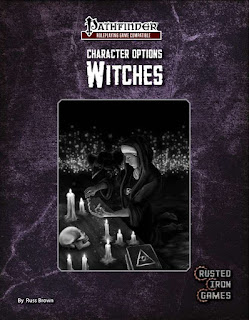 Going back to some Pathfinder tonight. I can't help it there is a lot of great Pathfinder content out there.
Going back to some Pathfinder tonight. I can't help it there is a lot of great Pathfinder content out there. As always I will be following my rules for these reviews.
PDF. $1.49. 7 pages. 1 page cover. ½page OGL. 5½ pages of content.
This PDF gives us what I consider the "usual bag" of options for the Pathfinder Witch class. NOTE that is not a slight on this book or even a bad thing. It is very, very often exactly what people want.
There are 10 new Patrons with their bonus spells. There are 10 new hexes as well.
There are three (3) new archetypes as well. These include the Devoted Witch (I might call this a Divine Witch or Witch Priestess), Green Witch (largely the same as mine in feel), and the Storyteller Witch which is a lot of fun. It is closest to my "Good Walker" witch.
So for just under $1.50 you can get all of this. Not at all bad really. If you need some new witch options then this is a good choice.

Mail Call: Print on Demand
I took advantage of the latest Christmas in July Sales at DriveThruRPG to get myself some Print on Demand deals.

I wanted a new Dragonlance hardcover to replace the one my son absconded with when he was little. I have also been wanting copies of City System and A Paladin in Hell for a while now. Cult of the Dragon and Minsc and Boo's Journal of Villainy are gifts for the aforementioned son.
While that was getting printed and shipped to me my youngest was 3D printing my Sagarassi minis.

They are a little hard to see, here is a close-up.

Yeah, still a little hard. Here is what they will look like painted.


I am pleased with how the prints turned out.


